Articles
China - Korea
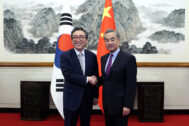
China - Korea
May — December 2024China and the Two Koreas’ Triangular Games
A rebound in China-ROK diplomacy raised optimism after a slow start to 2024, paving the way for the summit between Xi Jinping and Yoon Suk Yeol on Nov. 15. They met on the sidelines of APEC Peru before attending the G20 summit in Brazil. Foreign Ministers Wang Yi and Cho Tae-yul met in Beijing on May 13, facilitating the China-ROK-Japan trilateral summit and Yoon’s meeting with Premier Li Qiang in Seoul. As China-DPRK exchanges dwindled compared to the first third of this year, Xi Jinping and Kim Jong Un’s summits with Putin in May and June raised questions about the direction of China’s Korea policy. Donald Trump’s reelection in November intensified debate on the regional security and economic implications of US-China competition.
New Momentum in China-South Korea Partnership?
ROK Foreign Minister Cho Tae-yul’s May 13-14 visit to Beijing set a positive tone for this year’s high-level exchanges. It marked his first face-to-face talks with Foreign Minister Wang Yi since taking office in January, and the first visit to China by a ROK foreign minister since 2017. Cho raised hopes for a “new phase” of sustainable cooperation, “fostering mutual trust rather than solely focusing on the speed and volume of the development of the bilateral relationship.” They recognized space for further expanding economic cooperation, and agreed to boost local government and societal exchanges to improve mutual public perceptions. Setting up Yoon’s summits with Chinese Premier Li Qiang and Japanese Prime Minister Kishida Fumio in Seoul later that month, South Korea’s foreign ministry concluded the ministers’ meeting “created a new momentum for the development of the Korea-China relationship.”
President Yoon met Premier Li on May 26 in Seoul, a day before trilateral talks with Prime Minister Kishida. While focused largely on economic priorities, a key outcome of Yoon-Li talks was the reactivation and expansion of strategic communication channels. They agreed to create the Foreign Policy and Security Dialogue between foreign and defense ministries, after the halting of similar mechanisms a decade ago. Initiated on June 18 in Seoul, the “2+2” meeting was led by China’s Vice Foreign Minister Sun Weidong, Deputy Director of the Central Military Commission’s Office for International Military Cooperation Zhang Baoqun, South Korea’s Vice Foreign Minister Kim Hong Kyun, and Director General of the PRC Defense Ministry’s International Policy Bureau Lee Seung-buhm. It facilitated separate talks between Sun and Foreign Minister Cho. Cho met China’s vice Foreign Minister Ma Zhaoxu on July 24 in Seoul, where Ma and Korean counterpart Kim Hong-kyun led the 10th China-ROK high-level strategic dialogue, last held virtually in December 2021. ASEAN forums in Laos allowed foreign ministers Wang Yi and Cho Tae-yul to meet again on July 26 to reaffirm active progress in enhancing bilateral dialogue.
China and South Korea’s 9th trilateral summit with Japan on May 27 was highly anticipated after a four-year suspension. This year’s summit marked the 25th anniversary year of China-ROK-Japan cooperation stemming from the ASEAN+3 mechanism. Making “our bilateral relations and trilateral cooperation mutually reinforcing” topped Li’s five-point proposal, extending to trade, innovation, cultural exchange, and sustainable development. China’s foreign ministry stressed the summit’s “highly meaningful” value symbolizing a “new start” for trilateral cooperation. Supporting the Yoon administration’s optimistic reviews, Korean public opinion praised the summit’s significance for Northeast Asian security, the “central theme” of China-ROK ties, and overall “progress” despite China’s “different tone” on North Korea. The 8th trilateral business summit was held alongside the leaders’ meeting, hosted by the China Council for the Promotion of International Trade, Korea Chamber of Commerce and Industry, and Japan Business Federation.
The Xi-Yoon November summit renewed high-level support for developing the China-ROK “strategic cooperative partnership” in security, economic, and cultural fields. Xi and Yoon last met in November 2022 on the sidelines of the G20. China’s foreign ministry emphasized joint commitments to “the original intention of establishing diplomatic relations” despite “many changes” in the international environment since 2022. Yoon reiterated his vision for building a partnership based on “mutual respect, reciprocity, and common interests.”
Friction Points: Third Parties and Internal Affairs
The resurgence of China-ROK diplomacy from May failed to mask enduring strategic challenges. This year’s earlier lull in contacts magnified US-China competition and Yoon’s US-ROK alliance focus constrained the China-ROK partnership. For South Korean skeptics, besides agreeing to hold a good trilateral summit and intensify bilateral meetings, Foreign Ministers Wang and Cho in May “merely said what they wanted to say in diplomatic ways.” According to Yun Sun at the Stimson Center, Beijing’s primary motive for the trilateral summit was to “counterbalance US influence.” Featuring interviews with China’s Korea experts Zhang Huizhi at Jilin University and Da Zhigang at Heilongjiang Academy of Social Sciences, Chinese state media warned Japan and South Korea “should not lose their own interests following US’ suppression of China.” South Korea’s trilateral vice foreign ministerial meeting with US and Japanese allies right after the China-ROK-Japan summit was disappointing news indicating “Seoul’s diplomatic immaturity” and “hasty declaration of loyalty,” according to state think tank scholars like Dong Xiangrong.
Competing views of third-party actors, and interference in each other’s internal affairs, resurfaced in China-ROK diplomatic interactions. In Peru, Yoon held trilateral talks with Biden and Kishida the same day he met Xi. Launching a new Trilateral Secretariat, they renewed their 2023 Camp David pledges on Indo-Pacific and South China Sea maritime security, and Taiwan. South Korean media attention on November’s multilateral summits focused on Seoul’s quest to build global support on Korean security, and “free and fair trade” as host of APEC 2025. As Yoon’s key advisor Kim Tae-hyo reported after the Xi-Yoon summit, Yoon expressed hopes for cooperation with China “in response to North Korea’s repeated provocations, the war in Ukraine and military cooperation between Russia and North Korea.” While jointly applauding the “vitalization of bilateral exchange and cooperation in various areas,” Foreign Minister Cho told Vice Minister Ma in July, “North Korea’s continued provocations and its close ties with Russia are seriously threatening peace and stability on the Korean Peninsula and in the international community.” Although Cho communicated similar concerns to Wang in May, Foreign Minister Wang reaffirmed China’s “unchanged” Korea policy and “constructive role” on the peninsula.

Figure 1 Chinese Foreign Minister Wang Yi, also a member of the Political Bureau of the Communist Party of China Central Committee, holds talks with Cho Tae-yul, foreign minister of the Republic of Korea (ROK), in Beijing, capital of China, May 13, 2024. [Photo/Xinhua]
The Implications of Xi and Kim’s Summits with Putin
Beijing-Pyongyang high-level communication was limited to Xi and Kim’s exchange of anniversary messages on the DPRK’s founding in September and on PRC-DPRK diplomatic ties in October. Their bilateral summits with Putin in May and June raised more important implications for China-Korea relations. To commemorate the China-DPRK Friendship Treaty in July, the DPRK Embassy in Beijing hosted the foreign affairs chairman of the Chinese People’s Political Consultative Conference, He Ping. The lower level of DPRK representation at the Chinese Embassy reception compared to last year’s anniversary sparked speculation about the impact of Pyongyang’s cooperation with Russia. South Korean media in July interpreted various signs of widening division, including Beijing’s push to return DPRK workers in China in line with UN resolutions, its tightened monitoring of bilateral trade, and Kim Jong Un’s reported directive to China-based diplomats to “ignore China.” Pyongyang’s immediate denunciation of the May 27 China-ROK-Japan statement, coinciding with a failed satellite launch that night, raised similar speculation, reinforced by Beijing’s less explicit triangular alignment with Russian and DPRK allies.
Putin’s June 18-19 visit to Pyongyang for his historic summit with Kim raised China’s dilemma of managing historically-strained ties with North Korea and Russia, as 2024 marked the 75th anniversaries of China’s ties with both allies. In a July 23 Yonhap interview, DPRK defector and former diplomat Ri Il-gyu explained Pyongyang’s “estranged” ties with China since late 2022: “For North Korea, it is not a top priority to recover its ties with China. The North’s primary goal is to elicit the maximum benefit from Russia and map out its strategies to brace for Trump’s possible return…North Korea believes China does not make it live well, but it also thinks Beijing would not let it die of hunger.” The Putin-Kim summit’s timing with China-ROK 2+2 strategic talks on June 18 prompted China’s foreign ministry to assure that dialogue plans with Seoul have “no particular link to other countries.” Some observers saw the Putin-Kim summit as an opening for “Seoul-Beijing détente,” concluding “South Korea’s cooperation with China may prove to be more significant than Russia’s support for North Korea.” A JoongAng Daily editorial argued, such a scenario for Seoul first requires “exploiting Beijing’s concerns about its weakening leverage on Pyongyang and repercussions of a strengthened unity of the West,” before responding with the United States and other allies. At a June 17 Wilson Center forum, NATO Secretary General Jens Stoltenberg, who met President Yoon in Washington a month later, noted the growing importance of transatlantic cooperation with Indo-Pacific partners.
Xi’s summit with Putin on May 16 in Beijing, and Pyongyang’s ballistic missile test a day later, heightened skepticism about deterring North Korean aggression through UN sanctions. The meeting was even more disappointing for South Koreans in light of Foreign Minister Cho’s May 13-14 visit to Beijing, raising calls for South Korea’s own nuclear development or “NATO-style” cooperation. DPRK missile tests from May included a new record-setting Hwasong-19 intercontinental ballistic missile test on Oct. 31, Pyongyang’s 11th ICBM launch since 2021. While pointing to “large loopholes” in the global sanctions regime, ROK Ambassador to the UN Hwang Joon-kook called the test a move “to distract the world’s attention from its troops in Russia, demonstrate themselves as larger than life, or gain diplomatic leverage amid the US presidential election.” PRC Ambassador Fu Cong traced the peninsula security problem to a lack of US-DPRK “mutual trust,” and blamed US military expansion for threatening Chinese and regional security.
Talks between PRC and ROK nuclear envoys Liu Xiaoming and Lee Jun-il on the sidelines of the Northeast Asia Cooperation Dialogue in Tokyo on May 9 released no results. As Troy Stangarone at the Korea Economic Institute indicated, the April expiration of the mandate for the UN Panel of Experts on North Korea called into question the future of nuclear diplomacy. At a post-US election forum in Seoul, Trump’s former envoy Joseph Yun anticipated that Kim Jong Un is unlikely to resume denuclearization talks with Washington given stronger DPRK capabilities and Russian support.
China-ROK Economic Diplomacy and Trade Reset
China regained its position as South Korea’s biggest export market in January-July after ROK exports to the United States surpassed China’s share in April-June 2023. A 38% decline in memory chip exports to China last year contributed to South Korea’s first trade deficit with China since 1992. By December 2024, a recovery in semiconductor exports injected more optimism into South Korea’s trade performance. But the declining rate of ROK export growth from August implied longer-term concerns.

Figure 2 Finance Minister Choi Sang-mok speaks during the 18th Korea-China Meeting on Economic Cooperation held virtually with Zheng Shanjie, chairman of China’s National Development and Reform Commission, on May 16, 2024, in this photo provided by the Ministry of Economy and Finance. (PHOTO /Yonhap)
Agreements between President Yoon and Premier Li in May included the launching of a senior-level trade dialogue, resumption of the 2nd phase of FTA talks to promote the services sector, and revival of a bilateral investment cooperation committee after a 13-year pause.
The latest meeting of trade officials on Nov. 28 in Yancheng supported such priorities and facilitated a China-ROK business forum on the sidelines to explore new opportunities. Supply chain stability remained a top focus of bilateral economic diplomacy from May. China’s National Development and Reform Commission chairman Zheng Shangjie and ROK Finance Minister Choi Sang-mok led the 18th China-ROK Meeting on Economic Cooperation online on May 16. Choi pointed to a critical time for managing supply chains to “jointly lead the global industry,” citing raw materials and critical minerals, and new industries like clean energy. South Korea’s trade ministry announced new bilateral talks on July 11 “aimed at exchanging opinions on export controls.” The initiative complemented director general-level economic talks in Beijing on July 29, an exchange led by China’s Commerce Ministry and South Korea’s Foreign Ministry since 1993.
Regional Economic Security and Unfair Play
US-China technology competition and China’s e-commerce practices continued to drive China-ROK economic frictions. As US-China “protectionist moves” loomed over South Korea’s export recovery path, the latest exchange of the tightest-yet export controls under Xi and Biden drew mixed responses from South Korea. The trade ministry quickly projected limited repercussions for Korean semiconductors, reassuring the public on Seoul’s close coordination with Washington. Korean analysts suggested the barriers to China’s technology advancement could boost South Korea’s competitiveness, but also lower future Chinese demand and raise dependence on the US market. Ahead of US elections, a Korea Herald editorial summarized worsening fears in the shifting chip market: “Previously, roles were clearly assigned: the US led chip design; Europe excelled in related equipment; Korea and Taiwan spearheaded chip production for the global market; and China consumed the final chip products. This old chip production structure is now expected to undergo a wave of drastic changes now that the US is pivoting to “friendshoring” to keep China’s technology advance at bay.”

Figure 3 President Yoon Suk Yeol (R) and Chinese Premier Li Qiang pose for a photo during their meeting at the presidential office in Seoul on May 26, 2024. (PHOTO /Yonhap)
Such structural shifts framed Beijing and Seoul’s clashes over economic security and coercive diplomacy since the 2016-2017 THAAD dispute. During June 2+2 talks, Chinese officials opposed “turning economic issues into political or security ones,” and “all forms of trade protectionism.” ROK Industry Minister Ahn Duk-geun joined US and Japanese partners a week later in Washington to launch trilateral cooperation addressing “a wide range of non-market policies and practices” and “the weaponization of economic dependencies on certain supply sources for strategic goods.” South Korean opinion in May focused on the heightened need to manage mineral import reliance given “China’s strategic use of its core material resources as a geopolitical tool.”
Frictions over “unfair” practices also heated up in e-commerce. South Korea’s Fair Trade Commission (FTC) announced on May 13 the signing of voluntary agreements with AliExpress and Temu to address hazardous Chinese products and protect Korean consumers. By late November, the FTC ordered the online retailers to revise terms and conditions violating Korean legal standards on personal data protection and consumer compensation. Online purchases from China drove an annual 28% growth in direct overseas purchases by Korean consumers to 6.8 trillion won ($4.9 billion) in 2023, when China represented half of South Korea’s total overseas purchases. But the volume of user complaints about product quality and services has soared with China’s rapid expansion into the Korean market.
Against such consumer frustrations, the Xi-Yoon summit highlighted China’s granting of visa-free entry to South Koreans in early November, its first such move since 1992, as an immediate indicator favoring friendship through cultural exchanges. Xi “especially” welcomed more youth exchanges, and expressed hopes for more steps to boost China-ROK travel from the Korean side. Foreign Minister Cho also told Wang in May that freer access to cultural content would “help bridge the emotional gap between the youths of the two countries.” But China’s recent visa exemption drew cautious reactions in South Korea amid geopolitical uncertainties. While some supported the effort to mitigate recent strain, skeptics called China’s “sudden visa waiver” a strategic act to counter US influence, called for Seoul’s “prudent diplomacy,” and cautioned that reciprocal benefits to China require balancing economic gains and “less than favorable” public attitudes.
Resumption of China-DPRK Trade and Repatriation

Figure 4 President Yoon Suk Yeol (L) shakes hands with Chinese President Xi Jinping during their meeting at a hotel in Lima, Peru, on Nov. 16, 2024, on the sidelines of the Asia-Pacific Economic Cooperation summit. (PHOTO /Yonhap)
Post-pandemic reopening and increased trade with China and Russia drove North Korea’s economic recovery, as South Korean data showed in July. After negative economic growth from 2020, North Korea marked 3% growth in 2023, a doubling of exports to $0.33 billion, and 71% growth in imports to $2.44 billion. Trade with China constituted 83% of total DPRK trade last year. As the Korea Institute for International Economic Policy indicated in March, although remaining below 2018-2019 pre-pandemic levels, trade with China grew by more than 120% in 2023 to $2.29 billion, including $2 billion in imports and $0.29 billion in exports. Friendship Year initiatives also supported the resumption of China-DPRK people exchange. Student exchange programs resumed with the arrival of more than 80 PRC government scholarship and self-funded students in North Korea by May. The Chinese students represented the first foreign students to enter the country since North Korea’s August 2023 border reopening.
Global attention sharpened most importantly on China’s resumption of the forced repatriation of DPRK defectors, identified as illegal “economic immigrants.” Seoul repeated its requests for Chinese support though this year’s high-level meetings. In May, Foreign Minister Cho shared “domestic and international concerns” with Wang Yi, calling for “China’s special attention and cooperation to ensure that North Korean defectors are not repatriated against their will.” Seoul continued to push the human rights issue on the UN Security Council agenda by linking Pyongyang’s weapons development and human rights violations. ROK Ambassador Hwang Joon-kook said at a June 12 meeting: “If human rights violations stop, nuclear weapons development will also stop…This is why we need to look at the DPRK human rights situation from the perspective of international peace and security.” As Security Council president that month, he also delivered a joint statement by 57 UN member-states and the EU delegation calling for stronger collaborative action. China’s deputy representative Geng Shuang maintained that the UN Security Council “should not intervene in country-specific human rights issues…We’ve always opposed the politicization of human rights issues or using human rights as a pretext to exert pressure on other countries.”
Amid Seoul’s China-ROK-Japan summit preparations in May, various reports on China’s repatriations raised public calls for stronger diplomacy. A May 7 Korea Times editorial argued China “should pay more attention to improving its global reputation” as a UN Security Council permanent member and “major trading nation,” and called on the Yoon government to “adopt a more assertive approach and urge China to cease such improper actions.” Recent trends extend pessimism on Chinese cooperation. North Korea’s growing isolation poses a key challenge to South Korea’s rising activism, as Seoul’s UN Human Rights Office representative James Heenan indicated in May. Reports in June of North Korea’s construction of walls within the Demilitarized Zone affirmed views of tightening regime control against external influences. At a July CSIS event, ROK Unification Minister Yung Ho-kim pointed to the rising forces of South Korean popular culture against the DPRK regime’s juche culture of self-reliance, to promote cultural tools of influence. Such engagement strategies raised Chinese unease over threats to DPRK sovereignty. Citing President Yoon’s Oct. 9 Singapore Lecture on unification, Wang Junsheng at the Chinese Academy of Social Sciences criticized Yoon’s intensified “ideological offensive” “to influence DPRK citizens” as a leading driver of escalating peninsula tensions.
The 75th anniversary year of China-DPRK relations heightened Beijing’s challenge of promoting its global image while also consolidating its traditional friendship with Pyongyang. Mounting global criticism last year, in response to China’s October 2023 repatriation of more than 500 DPRK defectors, raised hope for constraining China’s actions. In August, the UN Human Rights Council Working Group on Arbitrary Detention urged China and North Korea to take steps to address the issue, after finding the case to be an “arbitrary deprivation of liberty” violating human rights norms. As Human Rights Watch reported in May, Beijing has detained more than 90 North Koreans since January, and forcibly repatriated more than 670 since Pyongyang’s 2020 border closure. China’s repatriation of about 60 North Koreans from Jilin and Liaoning on April 26, two weeks after China’s top legislator Zhao Leji met Kim Jong Un in Pyongyang, affirmed fears of increased repatriations.
Post-2025 Prospects for China-Korea Relations
Beijing-Seoul dialogue efforts this year recharged their “strategic cooperative partnership” forged in 2008 under Hu Jintao and South Korea’s conservative Lee Myung-bak administration, intended to expand ties to regional and global levels. China’s Korea watchers saw “multiple positive signals” this year of Yoon’s shifting China policy “beyond bilateral significance.” South Korea’s hosting of APEC 2025 raises much anticipation over a possible visit by Xi Jinping next year. But even Korean advocates of practical diplomacy cautioned, “President Yoon needs to moderate the speed of getting along with China” given the “mishaps” of previous administrations since Park Geun-hye, whose engagement with Xi from 2013 yielded a short-lived peak in partnership. Advancing the China-ROK partnership will require maintaining state and public diplomacy initiatives, delinking regional economic and security strategies, and avoiding discursive clashes on ideological differences.
The November election of Trump marked a critical juncture in China-Korea relations. On the security front, supporters of thawing China-ROK relations after the Xi-Yoon summit suggested “strengthening ties with Beijing could serve as a hedge against potential disruptions in the US-South Korea alliance.” Yoon’s media remarks on the G20 sidelines, indicating that relations with China and the United States is not “a case of choosing one country or the other,” signaled a major shift in his US alliance-centered foreign policy. While cautioning against “third party” influences, PRC Ambassador Xing Haiming in May agreed that “South Korea’s efforts to develop ties with the US, and also with China, do not go against one another.” Sharpened by the Xi-Putin summit, Yoon’s domestic criticism in May already projected an “inevitable” policy turn raised by voices favoring a “balanced” security approach. The June Kim-Putin summit raised Beijing and Seoul’s shared unease about Pyongyang’s tightening military ties with Russia. But the impending return of Trump’s “America First” revealed deeper South Korean anxieties about “choosing sides” on key priorities like Taiwan, and the security risks posed by Trump’s hardliners on China for resolving the North Korean nuclear issue.
The downward adjustments in South Korean growth projections after Trump’s November election reflected even stronger pessimism about the risks from US economic policy. As the presidential office reported after assessing the potential impact of Trump’s tariff plans, “A decline in China’s exports to the U.S. could affect Korea’s intermediate goods exports to China and may also intensify competition in third-country markets.” Korean public opinion captured the worsening economic outlook featuring ripple effects from US protectionism, the direct trade impact of technology restrictions on China, and wider repercussions from Chinese economic slowdown. From such perspectives, US-China competition dampens South Korea’s export drive if it is “forced to join a messy trade battle.” The Korea International Trade Association identified Trump’s tariff threats as the biggest risk facing ROK export recovery. A South Korean survey found that more than 80% of Korean companies expect Trump’s protectionist policy to hurt the Korean economy, while less than 8% think his China policy would benefit it. Such pessimism is amplified by an increasingly challenging foreign investment environment in China, where ROK direct investment dropped by 78% in 2022-2023 to $1.87 billion. One scholar affirmed in November, “China is country where political logic is strong…one cannot merely trust China as a business partner based purely on economic logic.”
Regaining trust at both state and societal levels remains a top priority for Beijing and Seoul. During his June meeting with former ROK Prime Minister Lee Hae-chan in Beijing, Wang expressed hopes for Korean efforts “to promote a correct understanding of China in the ROK society.” As South Korea’s Ambassador to China Chung Jae-ho argued in 2012 during the transition to China’s Xi era, “the wealthier and stronger China becomes, the larger the perceptual disparity may grow between China and its regional neighbors, including South Korea.” South Korea’s internal political turmoil compounds the geopolitical and economic risks from US-China competition under Trump. While Beijing declined commenting on Korean “domestic affairs,” the Chinese state media saw Yoon’s Dec. 3 imposition of martial law as a sign of “serious divisions in ROK politics.”
In conclusion, I want to thank Rob York, Brad Glosserman, Ralph Cossa, Carl Baker, and especially Scott Snyder for the valuable opportunity to contribute to Comparative Connections since 2008.
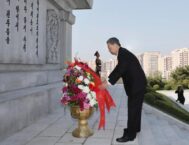
China - Korea
January — April 2024New Chapters, Old Dilemmas
China-ROK relations reached critical junctures across political, security, and economic fields. China-ROK relations had a bad start in 2024 with discord over regional security priorities. The inaugural US-Japan-ROK Indo-Pacific Dialogue in Washington on Jan. 5, a deputy foreign minister-level initiative emerging from the August 2023 Camp David summit, reignited frictions with Beijing. The resulting tensions constrained anticipation about their own trilateral summit with Tokyo. The shifting China-ROK trade structure and Chinese e-commerce practices emerged as central points of economic debate.
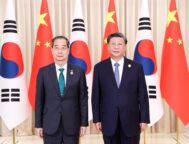
China - Korea
September — December 2023A Subdued Environment and Missed Opportunities
Chinese diplomacy toward the Korean Peninsula in late 2023 sputtered forward, driven more by a calendar of bilateral anniversaries with North Korea and multilateral gatherings involving South Korea than any sense of strategic purpose. Both relationships seemed preoccupied with off-stage developments such as the September summit between Kim Jong Un and Vladimir Putin and the momentum of US-Japan-South Korea trilateral relations, rather than any inherent dynamism of their own. Still, regular Sino-North Korean bilateral exchanges ahead of the 75th anniversary of the bilateral relationship and Sino-South Korean bilateral economic dialogues provide opportunities to overcome resistance and sustain progress in the face of deepening major power rivalries. Senior-level dialogues between China and North Korea occurred on North Korea’s 75th founding anniversary in September, with the visit of Chinese Vice Premier Liu Guozhong to Pyongyang, a visit that occurred against the backdrop of the second US-South Korea Nuclear Consultative Group meeting, North Korea’s first successful indigenous satellite launch, and North Korean Vice Foreign Minister Pak Myong Ho’s visit to Beijing.
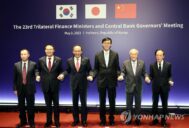
China - Korea
May — August 2023Economic Security Dilemmas
PRC Ambassador to South Korea Xing Haiming’s public statement in June sharpened Beijing-Seoul frictions following President Yoon Suk Yeol’s Taiwan remarks in an April interview, sparking mutual accusations of interference in internal affairs. Multilateral engagements offered opportunities to reaffirm China-ROK relations through bilateral talks between China’s Commerce Minister Wang Wentao and South Korea’s Trade Minister Ahn Duk-geun (May), Defense Ministers Li Shangfu and Lee Jong-sup (June), Foreign Ministers Wang Yi and Park Jin (July), Finance Ministers Liu Kun and Choo Kyung-ho (July), and Trade Ministers Wang Shouwen and Ahn (August). The revival of high-level exchanges, Beijing’s lifting of travel restrictions on South Korea in August, and North Korea’s border reopening that same month are sources of optimism in China-Korea relations despite overarching tensions. Discord remains on regional security priorities, South Korea’s overt alignment with the United States under the Yoon administration, and the escalating US-China technology war. Meanwhile, Chinese and Russian delegations joined Kim Jong Un in Pyongyang to celebrate the 70th anniversary of the end of the Korean War, reflecting the shape of North Korea’s first post-COVID diplomatic activity.
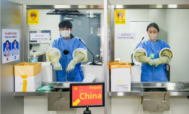
China - Korea
January — April 2023Deepening Suspicions and Limited Diplomacy
China and South Korea began 2023 with the temporary imposition of tit-for-tat restrictions by both governments on travel to the other country after China lifted its zero-COVID policy. Although the restrictions proved temporary, they pointed to the reality of a sustained downward spiral in China-South Korea relations accompanied by increasingly strident public objections in Chinese media to the Yoon Suk Yeol administration’s steps to redouble South Korean alignment with the United States regarding Indo-Pacific strategy, supply chain resiliency, and shared values. South Korean Minister of Foreign Affairs Park Jin’s congratulatory call to newly appointed Chinese Minister of Foreign Affairs Qin Gang on Jan. 9 was one of the few positive senior-level interaction between the two countries in early 2023; by the end of April, the main diplomatic interactions between China and South Korea had devolved into a dueling exchange of private demarches and public assertions that the other side had committed a “diplomatic gaffe.”
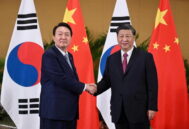
China - Korea
September — December 2022Kim Jong Un Tests Xi-Yoon Diplomacy
Regional and global summits presented high-level platforms for China-South Korea engagement in November. The summitry showed that the relationship had returned with solidity with the resumption of international meetings and in-person exchanges. Although the Xi Jinping and Yoon Suk Yeol leaderships advanced diplomatic exchange, concerns emerged over enduring political and security constraints and growing linkages with the economic relationship. Kim Jong Un’s escalation of military threats, through an unprecedented number of missile tests this year, challenged Xi-Yoon bilateral and multilateral diplomacy. China-North Korea bilateral interactions, while brisk, primarily relied on Xi and Kim’s exchange of congratulatory letters around significant founding anniversaries, China’s 20th Party Congress, and expressions of condolences after the death of former Chinese leader Jiang Zemin. The UN Security Council’s failure to take unified action on DPRK threats prompted South Korea to voice frustration with China and expand cooperation with US and Japanese partners. Such responses only reinforced concerns raised in recent leadership exchanges, and Korean domestic division over Yoon’s diplomatic strategies.
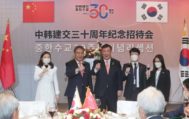
China - Korea
May — August 2022A Muted 30-Year Anniversary
Beijing and Seoul marked 30 years of diplomatic ties on Aug. 24 as South Korea transitioned to a new administration under President Yoon Suk Yeol, who took office in May. Although early high-level exchanges reaffirmed partnership, the two leaderships confront growing pressures from US-China competition, economic uncertainty, and public hostility. Domestic priorities in China in light of the 20th Party Congress and South Korea’s shift to conservative rule amplify these concerns. The impact of US-China rivalry on the China-South Korea relationship extends from security to economic coordination, including approaches to THAAD and global supply chains, and export competition, especially in semiconductors, challenges new Xi Jinping-Yoon economic agreements. Moreover, public hostility is strongest among South Korea’s younger generation, raising pessimistic prospects for future China-South Korea ties.
Despite mixed signals, false starts, and the continued absence of leader-level meetings marking the recovery of economic ties between China and North Korea, geopolitical developments have pushed the two countries closer together. Such engagement features mutual reinforcement of each other’s positions on issues of vital interest and solidarity in response to US policies.
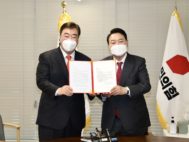
China - Korea
January — April 2022Beijing Olympic Tensions, North Korea’s Testing Spree, and South Korea’s New Conservative Leadership
The first four months of 2022 marked a turn toward difficult terrain in the China-South Korea relationship, including the challenge of managing conflicting expressions of patriotism during the Beijing Olympics. The Olympics opening ceremonies were attended by National Assembly Speaker Park Byung-seug, South Korea’s second-highest-ranking official by protocol, despite the US imposition of a “diplomatic boycott.” North Korea’s dozen missile tests since January 2022 included a “new” ICBM launch in March ahead of the 110thanniversary of Kim Il Sung’s birth and Yoon Suk-yeol’s presidential inauguration. The latest tests drove China-South Korea dialogue, new US sanctions, and reassertions from Beijing that US actions remain the decisive factor in resolving the peninsula problem. Beijing’s hosting of the Olympics and Pyongyang’s commemorations of Kim anniversaries presented opportunities for jointly reaffirming China-North Korea friendship. Despite signs of rebounding economic activity after the resumption of cross-border freight train operations in January, China’s COVID-19 lockdowns remain a source of uncertainty.
South Korea’s election of pro-US opposition candidate Yoon Suk-yeol generated a mixture of anxiety and veiled warnings from Chinese commentators. Chinese President Xi Jinping’s call to Yoon two weeks following the election was hailed as an unprecedented gesture of respect from a Chinese leader to an incoming South Korean president. But Yoon’s first congratulatory calls after his electoral victory were from Quad members as well as the United Kingdom, reflecting a distinct South Korean tilt toward the United States amid the China-US strategic rivalry. Yoon’s campaign platform posited a positive-sum relationship between his pledges to restore a “comprehensive strategic alliance” with the United States and to establish relations with China built on “mutual respect.” But it remains to be seen how Beijing will respond to the Yoon administration’s shift toward an unambiguous alignment with the US.
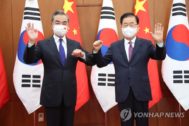
China - Korea
September — December 2021Economic Stabilization, End-of-War Declaration, and the Ongoing “Joint Struggle”
During the waning months of 2021, China and South Korea worked together to stabilize and strengthen their economic relationship and the Moon administration reached out to China as part of its full-court press to achieve an end-of-war declaration prior to the end of Moon’s term in May of 2022. Through several foreign minister-level meetings between Chung Eui-young and Wang Yi, including Wang’s visit to Seoul for a meeting with President Moon, an exchange held in Tianjin between national security advisors, and regular bilateral economic consultations, the two countries improved economic cooperation and sustained close consultation on peninsula-related issues. The most significant outcomes of these discussions included the first release of a major Korean movie in Chinese theaters since 2015 and ongoing efforts to bilaterally support the digital, technological, and climate change dimensions of Sino-South Korean economic cooperation. China offered support for Moon administration efforts to end the Korean War through pursuit of phased and synchronized actions and discouraged relevant countries from taking destabilizing unilateral moves.
Meanwhile, North Korea’s missile tests in September-October frustrated hope for regional diplomacy as Beijing and Pyongyang jointly commemorated their 72-year-old “joint struggle to defend and glorify socialism” by marking national and bilateral anniversaries. Their official statements, however, lacked substantive outcomes in China-DPRK diplomatic exchanges. Post-pandemic trade remained stalled as both leaderships turned to self-reliance in their national development strategy.
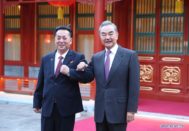
China - Korea
May — August 2021Alliance Restoration and Summit Commemorations
South Korea President Moon Jae-in’s meeting with Joe Biden and his participation in the G7 summit during May and June focused attention on Seoul’s strategy of balancing relations with China and the United States. While Beijing disapproved of the US-ROK joint statement released after the May summit, Chinese state media praised the Moon administration’s relative restraint in joining US-led coalition-building against China. Official remarks on core political and security issues, however, raised mutual accusations of interference in internal affairs. US-China competition and South Korean domestic political debates amplify Seoul’s dilemma regarding its strategic alignment ahead of the country’s 2022 presidential elections.
The China-North Korea relationship turned to commemorative diplomacy regarding summit meetings between Kim Jong Un and Xi Jinping in 2018 and 2019 in the absence of new meetings in 2021. Kim offered hearty congratulations to Xi on the occasion of the 100th anniversary of the founding of the Chinese Communist Party and both sides affirmed the value and historic contributions of the Sino-DPRK Treaty of Friendship, Cooperation, and Mutual Assistance on the occasion of the 60th anniversary of the signing of the treaty in 1961. Political messages underscoring China-North Korean strategic alignment included a North Korean statement affirming shared strategic priorities regarding both the US military withdrawal from Afghanistan and Chinese statements criticizing the continuation of annual US-South Korean military exercises in the context of rising China-US strategic rivalry.
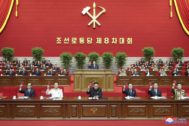
China - Korea
January — April 2021China-Korea Relations Poised for Recovery Despite Intensified Conflict on Social Media
China’s relations with North and South Korea gained momentum in the first four months of 2021. China-North Korea relations were propelled by an exchange of messages between North Korean leader Kim Jong Un and Chinese President Xi Jinping around North Korea’s successful convening of the Worker’s Party of Korea’s (WPK) Eighth Party Congress, the appointment of former North Korean Trade Minister Ri Ryong Nam as North Korea’s new ambassador to China, and another round of messages in March that emphasized the importance of close relations. In a Jan. 21 Cabinet meeting, South Korean President Moon Jae-in pledged to develop relations with China to new heights, and in a Jan. 26 telephone call with Moon, Xi expressed support for Korean denuclearization and joint development of China-South Korea relations. China and South Korea held consultations on maritime enforcement cooperation, defense lines of communication, health security, and free trade negotiations.
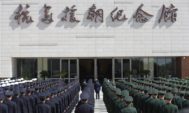
China - Korea
September — December 2020Strategic Dilemmas, Clashing Identities, and Free Trade
PRC State Councilor and Foreign Minister Wang Yi’s November visit to Seoul produced limited substantive results while signaling Beijing’s deeper strategic intentions toward the United States’ Asian allies. China’s commemorations of the Korean War’s 70th anniversary in October provided reassurances to North Korea while triggering a war of words with South Koreans, ranging from the foreign ministry to the K-pop group BTS. On social media, the history controversy was a prelude to wider cultural clashes on a host of issues. While the repercussions of COVID-19 and US-China trade tensions challenge China and South Korea’s economic agenda, the Regional Comprehensive Economic Partnership’s signing in November raised prospects for regional multilateralism. Meanwhile, North Korea’s self-imposed quarantine resulted in a precipitous drop in North Korean imports from China according to China’s official trade statistics. UN Panel of Experts-led monitoring of North Korean off-the-books exports of coal and sand to China drew harsh US criticisms and catalyzed the announcement of a US Treasury-administered rewards program for reporting on primarily Chinese entities engaged in illicit trade with North Korea. Coupled with the incoming Biden administration’s envisioned regional architecture and the campaign’s declared reliance on multilateral approaches to North Korea, Asia’s multilateral initiatives may heighten Seoul’s US-China dilemma.
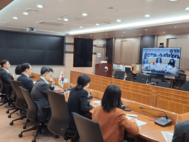
China - Korea
May — August 2020US-China Rivalry Divides the Two Koreas
The Korean Peninsula appears divided in what some analysts call a “new cold war” as US-China tensions escalate over issues ranging from COVID-19 to Hong Kong. Washington’s new China strategy prompted Pyongyang to voice its alignment with China while heightening Seoul’s dilemma of choosing sides. As the North Korean economy suffered the combined effects of ongoing sanctions, the global pandemic, and severe weather, a leaked UN report in August sharpened international criticism of China’s sanctions enforcement. The region’s current domestic political priorities reinforce Beijing, Seoul, and Washington’s trilemma over alternative approaches to DPRK denuclearization.
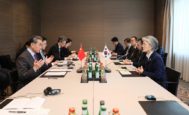
China - Korea
January — May 2020China-Korea Relations Under Quarantine
The outbreak of COVID-19, first in China and then in South Korea, placed plans for a highly anticipated summit between Xi Jinping and Moon Jae-in on hold. Beijing and Seoul’s priorities focused on fighting the virus together through aid exchanges, a new inter-agency mechanism led by their foreign ministries, and multilateral cooperation with Japan and ASEAN. As cases spread across borders, political frictions emerged over entry bans and relief supplies. The public health crisis triggered efforts to mitigate its socioeconomic repercussions, raising questions over long-term US influence. The virus also dramatically interrupted the normal diplomatic and economic interactions between China and North Korea.
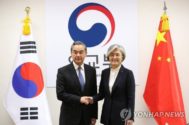
China - Korea
September — December 2019Nuclear Weapons Cloud 70 Years of Friendship
North Korea conducted five rounds of missile launches in this period as prospects for resuming dialogue with Washington dwindled. Although People’s Republic of China State Councilor and Foreign Minister Wang Yi praised Pyongyang’s diplomatic efforts during his September visit to the North, US-DPRK talks in October made no progress. The nuclear impasse loomed over 70th anniversary celebrations of China-DPRK diplomatic ties, highlighting the expanding friendship Chinese President Xi Jinping and North Korean leader Kim Jong-un envisioned last June. Amid concerns over escalating tensions on the Korean Peninsula, Beijing and Moscow proposed a draft UN resolution in December calling for the partial lifting of sanctions.
For their part, Beijing and Seoul advanced their strategic partnership through talks between Xi and South Korean President Moon Jae-in, the China-ROK-Japan summit in December, Wang’s visit to Seoul earlier that month, and the resumption of defense talks in October. But Moon’s latest China visit drew much domestic criticism for failing to secure Beijing’s cooperation on bilateral and regional priorities. Wang’s December visit to Seoul, meanwhile, was most remembered for his attacks on US “unilateralism” and “bullying.” US-China trade tensions and public clashes over Hong Kong present new challenges for the China-ROK partnership.
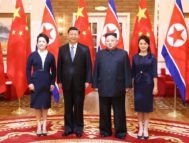
China - Korea
May — August 2019A New Chapter?
Beijing and Pyongyang celebrate 70 years of diplomatic relations this year. Xi Jinping traveled to Pyongyang in June for a fifth summit with Kim Jong Un, the first visit to North Korea by China’s top leader in 14 years. The meeting aimed to advance the bilateral friendship to a new phase of comprehensive development and drive regional coordination on the Korean Peninsula. In contrast, Xi’s 40-minute meeting with South Korean President Moon Jae-in on the sidelines of the G20 Summit in Osaka seemed to marginalize Moon, subordinate the relationship with South Korea, and place Xi as an intermediary between North Korea and the rest of world. Pyongyang’s missile tests, however, showed the limited effects of such diplomacy, even after surprise exchanges between US, North Korean, and South Korean leaders in Panmunjom on June 30. The current expansion of China-DPRK political, military, economic, and cultural exchanges also presents challenges to sanctions implementation and human rights promotion.
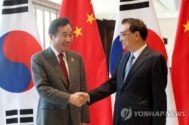
China - Korea
January — April 2019Post-Hanoi Hopes Trapped in a Sino-Korean Smog
China consolidated relations with North Korea through a fourth summit between President Xi Jinping and North Korean leader Kim Jong Un that set the stage for a second US-DPRK summit in Hanoi. This process was further symbolized by the presence of Xi and the senior Chinese leadership at a concert by a flagship North Korean art troupe in Beijing. The no-deal Trump-Kim summit in Hanoi left Kim empty handed and caught the Chinese leadership by surprise, removing any possibility of a fifth Xi-Kim meeting during Kim’s return train ride through China from Vietnam. It left Beijing concerned about the impasse, but hopeful that a mutual compromise might be salvaged. South Korean President Moon Jae-in’s reaction to the Hanoi summit failure had much in common with that of Beijing. But despite the visit to Beijing by Prime Minister Lee Nak-yon, smog hangs over China-ROK relations. Post-THAAD fallout and recriminations toward China resulting from worsening air pollution across the peninsula will set the diplomatic agenda for China-ROK relations through the rest of 2019.
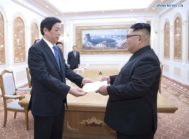
China - Korea
September — December 2018China Reaffirms Tradition: DPRK Friendship and Recovery of South Korean Ties
2018 was a diplomatic breakthrough year for Kim Jong Un, including three summits each with Presidents Xi Jinping and Moon Jae-in and a historic meeting with President Trump. After years of frustration over North Korea’s nuclear and missile development, the 70th anniversary of the founding of the DPRK in September was an occasion for consolidating the China-DPRK friendship. Prospects for regional coordination on North Korea, however, have been hindered due to challenges of implementation of international sanctions and deadlocked US-DPRK denuclearization negotiations. The focus on inter-Korean progress both overshadowed and enabled the gradual recovery of China-South Korea economic and political relations, but progress on North Korea’s broader regional integration remains murky, and the regional dimension of the Korean puzzle remains unclear.

China - Korea
May — August 2018China’s Multiple Roles in the Korean Drama
Building on the first Xi-Kim summit held in March, Kim Jong Un visited China twice on May 7-8 and June 19-20 for talks with President Xi Jinping, before and after the Trump-Kim summit on June 12. The Xi-Kim meetings affirmed Pyongyang’s commitments to peninsular peace and denuclearization embodied in the April 27 Panmunjom Declaration, but also raised South Korean uncertainties over China’s role and intentions. Although North Korea took its first step toward denuclearization by destroying its Punggye-ri atomic bomb test site, skeptics questioned the significance of the move. Beijing and Seoul forged a favorable environment for regional security cooperation by resuming working-level defense talks. Trilateral talks with Japan also resumed after a three-year deadlock. Despite indications of improving economic and cultural ties, the China-ROK security relationship remains constrained by strategic differences regarding implementation of the peace and denuclearization process.

China - Korea
January — April 2018Moon’s Olympic Diplomacy
The early months of 2018 may well be remembered as Kim Jong Un’s coming-out party. Beginning with his New Year speech calling for better inter-Korean relations, he suddenly became the topic of global attention and the “must have” partner for summits with both friend and foe. After seven years without any direct contact, Kim managed to meet both President Xi Jinping and President Moon Jae-in, and get a commitment for a meeting with US President Donald Trump within the span of two months. With the PyeongChang Winter Olympic Games and the flurry of diplomatic activity surrounding the Kim-centered summits serving as the primary catalysts, the prospect for a “breakthrough on the peninsula” became the central focus for China-Korea relations.
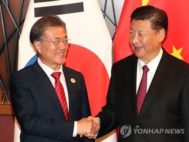
China - Korea
September — December 2017Business As Usual
North Korea showcased its sprint toward the capability to launch a nuclear strike on the US with a sixth nuclear test and more missile launches. Beijing supported sanctions adopted under UN Security Council Resolution 2375 and Resolution 2397, but continued to rejected calls for further pressure on the North. China continues to call for the North’s suspension of nuclear and missile activities in exchange for the suspension of US-ROK military drills, along with dual-track denuclearization and peace talks. Seoul and Beijing’s Oct. 31 agreement to “normalize” ties was a step toward returning the relationship to normalcy following a year-long dispute over THAAD, and paved the way to two summits between Presidents Xi and Moon. While defense ministers’ talks resumed on Oct. 24, these efforts at reconciliation relied on setting aside core security differences to avoid the economic costs of conflict. But these differences persist despite Beijing and Seoul’s shared desire to promote dialogue with Pyongyang and find ways to address rising peninsular tensions and the prospect of US-DPRK military conflict.
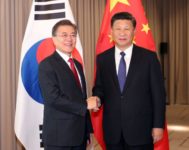
Days after Moon Jae-in’s presidential victory in Seoul on May 9, Pyongyang continued a series of missile tests that demonstrated the range and capability of its weapons, including an intercontinental ballistic missile capable of striking the United States. Early exchanges between Chinese leaders and the new Moon administration provided a chance to reset bilateral ties, including at Beijing’s Belt and Road Forum in June and South Korea’s hosting of the AIIB meeting in Jeju a month later. China supported the adoption of new UN Security Council Resolutions 2356 and 2371 on North Korea, pledging to enforce expanded sanctions and announcing domestic measures to enhance sanctions enforcement. The China-ROK strategic dialogue in June and the first Xi-Moon meeting in July, however, failed to narrow differences over THAAD, clouding Beijing and Seoul’s 25th anniversary celebrations of diplomatic normalization in August. Meanwhile, public attacks between Chinese and North Korean media indicate continued deterioration in the China-DPRK relationship.
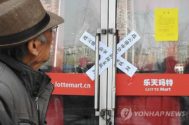
China - Korea
January — April 2017Two Koreas Defy Chinese Sanctions
Pyongyang tested regional and domestic politics on six separate occasions by conducting missile launches between February and April. The latest tests coincided with the Xi-Trump summit in Mar-a-Lago and Vice President Pence’s visit to South Korea. They also marked the 105th birth anniversary of Kim Il Sung on April 15 amid intense speculation that North Korea might conduct a sixth nuclear test. In addition to supporting five UN Security Council statements on North Korea this year, Beijing on Feb. 18 announced a suspension of DPRK coal imports through December. DPRK military threats also catalyzed US-ROK plans to deploy THAAD, a source of mounting tension that affected all aspects of the China-South Korea relationship. Beijing’s retaliation took the form of restrictions from March on business and tourism. South Korea appealed to the WTO for redress and South Korean lawmakers passed resolutions condemning China’s retaliation. THAAD emerged at the center of domestic political debate in Seoul after Park Geun-hye’s ousting on March 10, following which PRC nuclear envoy Wu Dawei in April engaged major presidential contenders ahead of the May 9 elections. Beijing’s falling out with both Koreas presents a major challenge for coordinating regional policy with new administrations in Washington and Seoul.
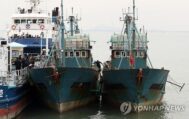
China - Korea
August — December 2016Nuclear Test, Political Fallout, and Domestic Turmoil
North Korea’s fifth nuclear test on Sept. 9 and the intensified test-firing of a range of missile types throughout 2016 underscored existing weaknesses in using dialogue and sanctions as a response. The timing of Pyongyang’s latest provocations coincided with the G20 Summit in Hangzhou and ASEAN-related meetings in Vientiane. President Park Geun-hye used the venues for sideline talks with President Xi Jinping and President Obama. The nuclear test directly challenged a nonproliferation statement adopted by East Asia Summit (EAS) members on Oct. 8, which urged North Korea to abandon its weapons programs. Following extended negotiations with the US, China finally joined the international community in adopting UN Security Council Resolution 2321 on Nov. 30. In addition to strains in the China-DPRK relationship, regional coordination on North Korea remains challenged by disputes between China and the ROK over THAAD and illegal Chinese fishing.
China - Korea
May — August 2016Relations in “Kim Jong Un’s Era”
Vice Chairman of the Workers’ Party of Korea (WPK) Central Committee Ri Su Yong visited Beijing at the end of May to deliver a message of friendship from Kim Jong Un and to report on the results of the May 6-9 WPK Congress, which reportedly marked the “official start to Kim Jong-un’s era.” Ri’s visit drew attention to Pyongyang’s nuclear policy as a continued source of friction in relations with Beijing. China-ROK tensions rose with the announcement of a US-ROK agreement to deploy the THAAD missile defense system in South Korea and South Korean protests against illegal Chinese fishing. Exclusive Economic Zones (EEZs) remain another point of China-ROK tension. Although China and South Korea seek to advance trade within various frameworks, such efforts only highlight a widening gap between the economic and political aspects of their relationship. Current security priorities require effective approaches to both immediate differences over THAAD and EEZs and longer-term preferences over how to effectively promote lasting stability on the Korean Peninsula.
China - Korea
January — April 2016New Sanctions, Old Dilemmas
North Korea’s fourth nuclear test in January and long-range rocket launch in February drew global opposition in the form of UN Security Council (UNSC) Resolution 2270 and condemnation by regional leaders. Pyongyang, however, promptly dismissed such calls with a series of short- and mid-range missile launches in March and April. Presidents Xi Jinping and Park Geun-hye expressed support for full implementation of UN sanctions in bilateral talks at the Nuclear Security Summit (NSS) in Washington. Foreign Ministers Wang Yi and Yun Byung-se pledged their commitment to denuclearization at the fifth Foreign Ministers Meeting of the Conference on Interaction and Confidence Building Measures in Asia (CICA) in Beijing on April 27-28, where Xi declared that China “will absolutely not permit war or chaos on the peninsula.” Despite Beijing’s hardened rhetoric, current tensions on the Korean Peninsula point to enduring differences between Beijing and Seoul’s strategic preferences.
China - Korea
September — December 2015A Complex China-ROK Partnership
The September China-ROK summit in Beijing catalyzed the resumption of trilateral talks with Japan in October and the launch of the China-ROK Free Trade Agreement in December. Beijing’s Korean engagement also included a visit to North Korea in October by Politburo Standing Committee member Liu Yunshan for 70th anniversary celebrations of the founding of the Workers’ Party of Korea (WPK). The visit was credited with preventing a rocket launch by Pyongyang that had reportedly been planned to mark the anniversary. Meanwhile, Pyongyang’s reached out to Beijing with a “friendship tour” to China led by Choe Hwi. Despite new initiatives to expand economic cooperation, Pyongyang’s apparent defiance of Chinese diplomatic efforts on denuclearization suggests further difficulties in Sino-DPRK relations.
China - Korea
May — August 2015Prospects for a Strategic Partnership?
President Park Geun-hye’s participation in China’s 70th anniversary celebrations of the end of WWII in September affirmed Seoul’s ties with China, while enabling Seoul to go on the offensive to win Beijing’s acceptance of a Seoul-led reunification of the Korean Peninsula. The escalation of inter-Korean tensions in late August revealed the dilemmas underlying Seoul’s regional diplomacy that continue to undermine coordination on North Korea and other security challenges. Nevertheless, both China and South Korea are engaging in parallel efforts to revive commercial ties with the North. Meanwhile, South Korea has made clear for now that its ability to engage China lies firmly on the foundations provided by a strong US-ROK security alliance; however, we expect that Beijing will continuously test Seoul’s allegiances.
China - Korea
January — April 2015South Korea’s Diplomatic Triangle
A theme of South Korean opinion leaders in recent years has been the desire to avoid choosing between Beijing and Washington, but this strategy became more difficult in early 2015, as Seoul had to decide how to deal with issues such as AIIB (Asian Infrastructure and Investment Bank) and THAAD (Terminal High Altitude Area Defense) where Beijing and Washington are on opposing sides. As South Korea weighed these choices, there was a series of high-level Chinese visits to South Korea, including Vice Premier Wang Yang’s to discuss furthering China-ROK economic and cultural cooperation on the foundation of closer political ties and State Councilor and Defense Minister Chang Wanquan to reaffirm opposition to Pyongyang’s nuclear weapons program. On the economic front, China and South Korea are pushing to sign their FTA deal this year, holding the latest trade meeting on April 9. Meanwhile, normalization of regional relations in Northeast Asia moved forward with the resumption of trilateral foreign ministerial talks with Japan on March 21 in Seoul.
China - Korea
September — December 2014Beijing Ties Uneven with Seoul, Stalled with Pyongyang
Although North Korea’s diplomatic activity in 2014 spiked with senior-level outreach to Southeast Asia, Iran, Russia, the Middle East, Africa, and the United Nations, Beijing has been little more than a stopover for these officials. China-DPRK security and economic ties remain strained as Pyongyang continues its dual pursuit of nuclear and economic development. Instead, South Korean politicians and diplomats have been flocking to Beijing for endless consultations. Multilateral engagements were the primary venue for maintaining the momentum in high-level China-South Korea exchanges following the Xi-Park summit in July. The seemingly perennial agenda for discussion between the two countries was North Korea, followed by discussion of China-South Korea trade, including the announcement that the two countries would meet their end-of-year target to conclude negotiations on a free trade agreement (FTA).
China - Korea
May — August 2014Balancing Acts by China and South Korea
Presidents Xi Jinping and Park Geun-hye met in Seoul while North Korea conducted a series of short-range missile and artillery tests. The summit produced a joint statement reaffirming cooperation on Korean denuclearization, but Chinese efforts to form a united front in opposition to Japan on history and collective self-defense issues were rebuffed. Instead, they agreed to move forward on negotiating a China-ROK free trade agreement. Beyond the summit, China-South Korean exchanges remained focused on the North Korean nuclear issue and reviving the Six-Party Talks. Pyongyang has maintained limited contacts with Beijing while attempting to diversify its contacts with other political and economic partners.
China - Korea
January — April 2014China’s Red Line on the Korean Peninsula
In early January South Korean President Park Geun-hye said relations with China had reached an historic high point, but North Korean belligerence posed a challenge to implementation of the China-ROK Joint Statement. Despite increased tensions on the peninsula, China and the ROK have continued to build on their cooperative strategic partnership. President Xi Jinping and Park met on the sidelines of the Nuclear Security Summit and talked by telephone a month later. Premiers Li Keqiang and Jung Hong-won met on the sidelines of the Boao Forum for Asia in Hainan, while Foreign Ministers Wang Yi and Yun Byung-se held periodic telephone talks. In contrast, China-DPRK contacts have been limited to low-level visits and routine “friendship” exchanges. The highest level meeting was between President Xi and Kim Yong Nam on the sidelines of the Sochi Winter Olympics. China’s engagement with the DPRK has focused primarily on mediating the resumption of the Six-Party Talks.
China - Korea
September — December 2013Crying Uncle No More: Stark Choices for Relations
New strategic challenges have emerged in recent months that will influence China’s relations with both Koreas into the New Year. China’s declaration of an ADIZ that overlaps South Korean jurisdictional claims and developments inside North Korea emerged in November as two priority concerns in Sino-South Korean relations, obscuring more mundane areas of progress in implementing the June 2013 Park-Xi summit statement. Meanwhile, Sino-DPRK relations appeared to suffer a setback following the Dec. 13 execution of Jang Song Thaek, raising concern about policy changes that might result. Kim Jong Un’s strategy of simultaneous nuclear and economic development remains in conflict with Beijing’s priorities, reinforcing widespread pessimism over prospects for the renewal of talks on Korean denuclearization.
China - Korea
May — August 2013How Does China Solve a Problem Like North Korea?
China-Korea relations entered an active phase of leadership exchanges following North Korea’s satellite launch, its nuclear test, and the passage of UN Security Council resolutions condemning these actions. Although the aftermath drove continued debate on the extent of Chinese leverage and patience with Pyongyang, Beijing has reaffirmed its commitment to bring North Korea back to multilateral talks through revived bilateral exchanges with Pyongyang. Beijing’s frustration with its North Korean ally has expanded Chinese willingness to include denuclearization as a policy objective it shares with the US and South Korea, but differences remain regarding long-term strategic interests and the preferred tools for pursuing the objective.
China - Korea
January — April 2013Seeking Alignment on North Korean Policy
South Korea and China both welcomed new leaders as Park Geun-hye and Xi Jinping began their presidential terms. Both leaders sent signals prior to assuming power that they wanted to repair relations that had frayed under their predecessors. They also faced an early challenge from Kim Jong Un as North Korea defiantly responded to two UN Security Council resolutions condemning Pyongyang’s December 2012 rocket launch and third nuclear test. Escalating tensions in Korea provided an urgent rationale for Park and Xi to redouble efforts to establish a stable relationship and to respond to North Korean provocations. China and South Korea must establish a productive relationship and coordinate policies toward North Korea in an increasingly challenging regional political and strategic environment.
China - Korea
September — December 2012Under New Leaderships
The appointment of Xi Jinping as general secretary of the Chinese Communist Party on Nov. 15 and the election of Park Geun-hye as president of South Korea on Dec. 19 raised hopes for improvement in China-South Korea relations. Pyongyang’s Dec. 12 rocket launch provides an early challenge at the UN Security Council, where South Korea begins a two-year term alongside permanent members China and the US. Xi and Park will face a full agenda that includes management of growing economic ties, policy toward North Korea, and a complex regional environment beset by territorial and historical disputes. Another factor complicating the regional picture is that both leaders face territorial disputes with Japan under returning Liberal Democratic Party (LDP) Prime Minister Abe Shinzo.
China - Korea
May — August 2012Managing Relations amidst Power Transitions
Senior-level dialogue between China and North Korea resumed this summer when head of the Chinese Communist Party (CCP) International Department Wang Jiarui became the first senior foreign visitor to meet Kim Jong Un. Previously, there had been a great deal of speculation regarding the absence of leadership exchanges since Kim Jong Il’s death. Several other high-level exchanges followed. Discussions focused on reconciling priorities and Chinese support for Kim Jung Un’s consolidation of power. Although more subdued, there were also several high-level exchanges between China and South Korea as they celebrated the 20th anniversary of diplomatic ties, initiated talks on establishing a bilateral free trade agreement, held the second round of strategic defense talks, and sparred over South Korean concerns about human rights.
China - Korea
January — April 2012China’s Post-Kim Jong Il Debate
The 20-year anniversary of diplomatic relations between China and South Korea may provide a pretext for more active diplomacy to meet a growing list of potential disputes in the relationship. Presidents Hu Jintao and Lee Myung-bak have held two summits this year and there has been increased interaction among other senior leaders as well. These exchanges have sharpened focus on the prospects for the partnership. Meanwhile, high-level contacts between China and North Korea have stalled. Beijing renewed calls for restraint following North Korea’s failed launch of an “earth observation satellite” and a UNSC President’s Statement strongly condemning it. This has dampened China’s hopes for regional engagement.
China - Korea
September — December 2011New Challenges in the Post Kim Jong Il Era
Beijing underscored maintaining peace and stability on the Korean Peninsula following Kim Jong Il’s death. North Korea’s leadership succession raises questions about the future direction of China’s Korea policy, which was most recently reaffirmed during an October visit to the two Koreas by Vice Premier Li Keqiang, the presumed successor of Premier Wen Jiabao. Li met Kim Jong Il, top legislator Kim Yong Nam, and Premier Choe Yong Rim in Pyongyang, and met President Lee Myung-bak, Prime Minister Kim Hwang-sik, and Parliamentary Speaker Park Hee-tae in Seoul.
Prior to Kim Jong Il’s death, China and North Korea maintained regular high-level contacts at the state, party, and military level. DPRK Premier Choe Yong Rim visited China in late September. He met President Hu Jintao and Premier Wen Jiabao in Beijing and toured Chinese companies in Shanghai and Jiangsu. A Communist Party of China (CPC) delegation led by Guo Shengkun, alternate member of the CPC Central Committee and secretary of the CPC Guangxi Zhuang Autonomous Regional Committee, paid a visit to North Korea in early October and met top legislator Kim Yong Nam. Li Jinai, director of the General Political Department of the People’s Liberation Army (PLA), led a military delegation to North Korea in mid-November and met senior DPRK officials including Kim Jong Il.
There have also been mutual efforts to stabilize Sino-South Korean relations despite many differences that have risen in the aftermath of North Korea’s 2010 provocations. The fourth China-ROK high-level strategic dialogue was held on Dec. 27 in Seoul, where Vice Foreign Minister Zhang Zhijun met ROK counterpart Park Suk-hwan, Foreign Minister Kim Sung-hwan, and Unification Minister Yu Woo-ik. Foreign Ministers Yang Jiechi and Kim Sung-hwan met on the sidelines of the annual UN General Assembly session in New York on Sept. 20. President Lee and Premier Wen attended regional meetings in Bali on Nov. 18-19, including the ASEAN Plus 3 Summit, East Asia Summit, and a China-ROK-Japan trilateral meeting. Special Representatives Wu Dawei and Lim Sung-nam held talks on Korean Peninsula denuclearization in November and December in Beijing.
China - Korea
May — August 2011A Fragile China-ROK Strategic Partnership
High-level exchanges between China and South Korea’s foreign and defense ministries appeared to recover momentum as the two countries marked their 19th anniversary of diplomatic relations on Aug. 24. The first China-ROK “strategic defense dialogue” was held in Seoul on July 27 following talks between Defense Ministers Liang Guanglie and Kim Kwan-jin in Beijing on July 15 and in Singapore on June 4 on the sidelines of the Shangri-La Dialogue. Foreign Ministers Yang Jiechi and Kim Sung-hwan met June 6 ahead of the Asia-Europe Foreign Ministers Meeting in Budapest and held another round of talks July 21 in Bali on the sidelines of ASEAN regional meetings. But efforts to consolidate the China-ROK strategic partnership have exposed policy differences over North Korea and the ROK alliance relationship with the US.
China and North Korea commemorated the 50th anniversary of the Treaty of Friendship, Cooperation and Mutual Assistance in July. Kim Jong Il visited China on May 20-26, holding talks with President Hu Jintao and Premier Wen Jiabao. He returned Aug. 25-27 and met State Councilor Dai Bingguo in Heilongjiang province on his way back from a meeting in Siberia with Russian President Dmitry Medvedev. Kim’s May visit was publicly revealed during bilateral talks between Premier Wen and President Lee on the sidelines of the fourth Trilateral China-ROK-Japan Summit in Tokyo. Communist Party of China (CPC) and DPRK counterparts held an unprecedented “strategic dialogue” ahead of the 90th anniversary of the CPC in June. China and North Korea also agreed to strengthen military cooperation during a visit by a Korean Peoples’ Army (KPA) delegation to China on Aug. 25-26. China and North Korea’s new joint economic projects have raised debate on the prospects for North Korean reform. DPRK denuclearization efforts remain stalled despite apparent increases in regional diplomatic efforts toresume the Six-Party Talks.
China - Korea
January — April 2011Can Inter-Korean Dialogue Revive the Six-Party Talks?
In the aftermath of North Korea’s artillery shelling of Yeonpyeong Island on Nov. 23, 2010, Chinese officials showed great concern about the possibility of escalation, focusing special concern on the possibility that South Korean military exercises might lead to military escalation. The January summit between Presidents Hu and Obama served to reduce tensions to some degree, especially through a call for resumption of inter-Korean talks in the US-China Joint Statement released at the summit. Following the apparent stabilization of inter-Korean relations, China has stepped up calls for “creating conditions” for the resumption of Six-Party Talks, engaging in diplomatic exchanges with both Koreas, including meetings between Special Representative for Korean Peninsula Affairs Wu Dawei and ROK nuclear envoy Wi Sung-lac on Feb. 10-11 in Beijing and again on April 26 in Seoul, and through DPRK Vice Minister Kim Kye Gwan’s meetings in Beijing with Wu Dawei, Foreign Minister Yang Jiechi, and Vice Foreign Minister Zhang Zhijun respectively in mid-April in China. Although South Korea in April agreed to China’s proposed “three-step” process toward restarting Six Party Talks – (1) Inter-Korean, (2) US-DPRK, and (3) Six-Party Talks – this plan makes the resumption of multilateral talks depend most critically on reaching consensus on the preconditions for inter-Korean talks, which remain stalled since a preparatory meeting for inter-Korean defense ministers’ talks broke down in February.
Despite the regional stalemate on DPRK denuclearization, China and South Korea have attempted to stabilize and consolidate cooperation on other issues. Foreign Minister Yang met President Lee Myung-bak in Seoul on Feb. 23. ROK Foreign Minister Kim Sung-hwan returned the visit on March 28-30 and met Premier Wen Jiabao and Wang Jiarui, head of the party’s international department. ROK Prime Minister Kim Hwang-sik visited China in April, holding talks with President Hu Jintao in Sanya, Hainan Province on April 14, and with Wen Jiabao and China’s top legislator Wu Bangguo in Beijing on April 13. Chinese and ROK leaders also held a series of three-way talks with Japanese counterparts, including a ministerial conference on culture on Jan. 11 in Nara, a foreign ministers meeting on March 19 in Kyoto, trade ministers talks on April 24 in Tokyo, and an environment ministers meeting on April 29 in Busan.
China - Korea
October — December 2010DPRK Provocations Test China’s Regional Role
North Korea’s artillery attack on Yeonpyeong Island on Nov. 23 placed the Korean Peninsula at the center of regional attention and intensified diplomatic pressures on China as an indispensable player. Beijing mobilized a remarkably swift diplomatic effort in response, sending State Councilor Dai Bingguo to Seoul to meet President Lee Myung-bak and Foreign Minister Kim Sung-hwan, and to Pyongyang to meet Kim Jong Il and Vice Premier Kang Sok Ju. Chinese calls for regional dialogue intensified with South Korean efforts to deter North Korea through joint naval exercises with the US in the Yellow Sea and live-fire artillery drills. Despite urgent Chinese entreaties to convene “emergency consultations” among senior envoys, North Korean provocations appeared to undermine already limited prospects for Six-Party Talks. Beijing’s persistent calls for both Koreas to return to dialogue and Seoul’s apparent support for inter-Korean dialogue and Six-Party Talks, may open the way for a return to negotiations, but South Korea’s position remains conditional upon North Korea acknowledging its responsibility for provocations and taking concrete steps to show its commitment to denuclearization.
Following North Korea’s Workers’ Party of Korea (WPK) Conference on Sept. 28, China and North Korea took unprecedented steps to consolidate political ties through historic high-level party and military exchanges in October commemorating the 65th anniversary of the founding of the WPK and the 60th anniversary of the entry of the Chinese People’s Volunteers (CPV) into the Korean War. Zhou Yongkang, member of the Standing Committee of the Political Bureau of the Communist Party of China (CPC) Central Committee and Secretary of the CPC Political and Legislative Affairs Committee, led a party delegation to North Korea and met Kim Jong Il and Kim Yong Nam, president of the Presidium of the DPRK Supreme People’s Assembly. A week later, Kim Jong Il received CPV veterans and a Chinese military delegation to Pyongyang led by Guo Boxiong, Vice Chairman of the Central Military Commission, who also held talks with Ri Yong Ho, vice chairman of the WPK Central Military Commission. ROK and Chinese leaders, meanwhile, met on the sidelines of major regional and international summits. Presidents Lee Myung-bak and Hu Jintao met at the G20 Summit in Seoul and Foreign Ministers Kim Sung-hwan and Yang Jiechi met ahead of ASEAN-related summits in Hanoi. President Lee and Premier Wen Jiabao met at the Asia-Europe Meeting in Brussels and held trilateral talks with Japanese Prime Minister Kan Naoto in Hanoi.
China reaffirmed its traditional friendship with a revamped leadership in Pyongyang that emerged from the historic Workers’ Party of Korea (WPK) conference that re-elected Kim Jong-il as party and state leader. Kim Jong-il visited Northeast China, holding his second summit with President Hu Jintao this year. Immediately after Pyongyang’s party conference, Secretary of the WPK Central Committee Choe Tae-bok led a senior party delegation to Beijing to brief President Hu and other officials. Meanwhile, China-ROK relations remain strained following the March 26 Cheonan incident, marking the lowest point in bilateral relations since diplomatic normalization in 1992. The third China-ROK high-level strategic dialogue was held in Beijing. China and South Korea also held their first preliminary round of free trade agreement talks. Beijing promoted resumption of the Six-Party Talks, sending Special Representative for Korean Peninsula Affairs Wu Dawei to meet counterparts in Pyongyang and Seoul.
China - Korea
April — June 2010The Cheonan and China’s “Double Play”
The March 26 sinking of the South Korean warship Cheonan in the West Sea that killed 46 soldiers served as the backdrop for a series of high-level exchanges between China and the two Koreas as China came under international pressure to provide a tough response to the incident. Kim Jong-il paid an “unofficial” visit to China on May 3-7 and met President Hu Jintao in Beijing, days after ROK President Lee Myung-bak’s summit with Hu. Kim’s delegation included senior officials from the Foreign Ministry, Worker’s Party of Korea, and the DPRK Cabinet. Lee attended the April 30 opening ceremony of the 2010 World Expo in Shanghai, where President Hu also met the DPRK’s top legislator Kim Yong Nam. Lee and Hu held another round of bilateral talks on the sidelines of the G20 Summit on June 26 in Toronto, where they pledged to strengthen the China-ROK strategic cooperative partnership despite unresolved tensions over North Korea. Premier Wen Jiabao paid a three-day visit to South Korea on May 28-30 and met President Lee in Seoul prior to the third China-ROK-Japan trilateral meeting in Jeju. Foreign Ministers Yu Myung-hwan and Yang Jiechi also held talks on the sidelines of the fourth trilateral foreign ministers meeting with Japan on May 15-16 in Gyeongju.
South Korea formally referred the Cheonan case to the UN Security Council on June 4 after results of an international investigation were released on May 20 indicating that the warship sinking was caused by a North Korean torpedo. Meanwhile, Beijing has repeatedly called for “calm and restraint” in dealing with the crisis. South Korean media criticized President Hu for remaining “non-committal” toward the sinking of the Cheonan at his summit with President Lee in Toronto, where Hu stated that “China opposes and condemns any act that would undermine stability in the region” but did not make any reference to North Korea.
China - Korea
January — March 2010Fire Sale, Hot Money, and Anxieties about “Investment”
China and North Korea sustained high-level contacts during the quarter, but there seems to be little to show for it. Wang Jiarui, head of the International Department of the Communist Party of China (CPC) Central Committee, met Kim Jong-il in Pyongyang and delivered a letter from President Hu Jintao, reportedly extending an invitation to Kim to visit China. Following the visit, the Chinese Foreign Ministry confirmed Pyongyang’s “persistent stance” toward denuclearization while Hu affirmed that friendly ties is China’s “consistent policy” toward Pyongyang. Two weeks later Kim Yong-il, director of the International Affairs Department of the Workers’ Party of Korea (WPK) Central Committee, visited Beijing, where he met President Hu. North Korea’s major push to attract foreign investment appears to involve potential economic deals that Beijing has claimed do not violate UN resolutions toward the North. Meanwhile, Chinese leaders presented a positive outlook for the resumption of Six-Party Talks on the sidelines of the annual session of the National People’s Congress (NPC) and Chinese People’s Political Consultative Conference (CPPCC) in March. Having received the title of representative for Korean Peninsula Affairs, China’s lead representative to the Six-Party Talks Wu Dawei stated that talks might resume before July this year in light of favorable diplomatic contacts with Pyongyang. Foreign Minister Yang Jiechi expressed support for improved inter-Korean and US-DPRK ties. China and South Korea officially launched Visit China Year 2010, pledging to strengthen their strategic cooperative partnership through intensified diplomatic, cultural, and economic exchanges. ROK Foreign Minister Yu Myung-hwan held talks with Premier Wen Jiabao and Foreign Minister Yang Jiechi in Beijing.
China - Korea
October — December 2009Embracing the ROK Economically and the DPRK Politically
The last quarter of 2009 raised hopes for developments in China’s relations with both Koreas. Chinese Vice President Xi Jinping received head-of-state treatment during his mid-December visit to South Korea. In Seoul, Xi presented a series of proposals to further the China-ROK strategic cooperative partnership, including pressing for a free trade agreement. President Lee Myung-bak and Premier Wen Jiabao held bilateral talks on Oct. 10 in Beijing on the sidelines of the China-ROK-Japan trilateral summit, which Lee used to promote his “grand bargain” on North Korean denuclearization.
There were also several exchanges between China and the DPRK. In early October, Premier Wen led a large delegation to Pyongyang and proposed a comprehensive set of deals with North Korea. As the first Chinese premier to visit Pyongyang in 18 years, Wen was warmly hosted by Kim Jong-il. Following Wen’s visit, the director of the United Front Department of the Workers’ Party of Korea (WPK) and Pyongyang’s official in charge of inter-Korean relations, Kim Yang-gon, made a five-day trip to China. President Hu Jintao reportedly extended a formal invitation to Kim Jong-il to visit China “at a convenient time” at his meeting with Choe Thae-bok, secretary of the WPK Central Committee and one of Kim’s closest aides, who led a WPK delegation to Beijing in late October.
China - Korea
July — September 2009China’s Nuclear North Korea Fever
North Korea’s missile tests in early July marked an apparent peak in its provocative behavior as Pyongyang shifted to a “charm offensive” strategy toward the international community from August. Pyongyang’s turn toward diplomacy has shifted attention to a series of meetings between North Korea and the international community, including Kim Jong-il’s talks with former U.S. President Bill Clinton and Hyundai Chairperson Hyun Jung-Eun in August, China’s State Councilor Dai Bingguo in September, and finally Premier Wen Jiabao in early October. Kim Jong-il’s encouraging statement regarding prospects for renewed multilateral and bilateral dialogue during Dai’s visit and his further statement during Wen’s visit that “the DPRK is willing to attend multilateral talks, including the Six-Party Talks, based on the progress in the DPRK-U.S. talks” has set the stage for new engagement with North Korea by the U.S. and the international community. It remains to be seen if this engagement will lead to tangible North Korean actions in the direction of denuclearization.
Presidents Lee Myung-bak and Hu Jintao both traveled to the U.S. in September for the G20 summit in Pittsburgh and UN General Assembly in New York, where they met on the sidelines to discuss North Korea and other issues in their strategic cooperative partnership. The Lee-Hu summit came days after Lee’s “grand bargain” proposal for dealing with North Korea, which seeks complete and irreversible denuclearization in exchange for a full package of incentives. While Lee noted China’s recent diplomatic outreach to North Korea, it is unclear whether Beijing is on board with Lee’s plan or has its own plans for dealing with North Korea.
China - Korea
April — June 2009Pyongyang Tests Beijing’s Patience
North Korea’s missile launch on April 5 and nuclear test on May 25 posed a test to the international community following two UN Security Council resolutions in 2006 condemning North Korea’s actions. For China, the tests again highlighted the tensions between its emerging role as a global actor with increasing international responsibilities and prestige and a commitment to North Korea as an ally with whom China shares longstanding historical and ideological ties. On June 12, China voted in favor of UN Security Council Resolution 1874 condemning North Korea’s nuclear test, banning sales of nuclear and missile-related technology and heavy weapons to North Korea, authorizing financial sanctions against companies involved with North Korea’s missile and nuclear programs, and authorizing the implementation of an inspections regime for suspect shipments into and out of North Korea. China now must decide whether it will actively implement the resolution. As a result of North Korea’s declining trade with South Korea and the international community, China’s economic leverage with North Korea has grown. But it is unclear whether China will utilize such leverage given strategic concerns about regional stability and the impact on the political succession process now underway in Pyongyang.
Meanwhile, economic policymakers in Seoul are aggressively seeking to expand South Korea’s share of the Chinese market in an effort to shore up the economy and benefit from Beijing’s massive stimulus plan. However, there is growing Sino-South Korean competition to secure overseas export markets and energy sources. This competition is influencing South Korean assessments of China’s role as a global economic power.
China - Korea
January — March 2009Year of China-DPRK Friendship; North’s Rocket Fizzles
Top-level diplomacy between Beijing and Pyongyang intensified this quarter in honor of China-DPRK Friendship Year and the 60th anniversary of diplomatic relations. Prior to the Lunar New Year holiday in mid-January, Kim Jong-il held his first public meeting since his reported illness with Chinese Communist Party International Liaison Department Head Wang Jiarui. In March, DPRK Prime Minister Kim Yong-il paid a return visit to Beijing. The Chinese have accompanied these commemorative meetings with active diplomatic interaction with the U.S., South Korea, and Japan focused on how to respond to North Korea’s launch of a multi-stage rocket. Thus, China finds itself under pressure to dissuade Pyongyang from destabilizing activity and ease regional tensions while retaining its 60-year friendship with the North. Meanwhile, South Korean concerns about China’s rise are no longer confined to issues of economic competitiveness; the Korea Institute for Defense Analysis has produced its first public assessment of the implications of China’s rising economic capabilities for South Korea’s long-term security policies. The response to North Korea’s rocket launch also highlights differences in the respective near-term positions of Seoul and Beijing. Following years of expanding bilateral trade and investment ties, the global financial crisis provides new challenges for Sino-ROK economic relations: how to manage the fallout from a potential decline in bilateral trade and the possibility that domestic burdens will spill over and create new strains in the relationship.
China - Korea
October — December 2008Sweet and Sour Aftertaste
High-level interaction between Presidents Hu Jintao and Lee Myung-bak continues to intensify following the upgrading of the Sino-South Korean relationship to a “strategic cooperative partnership” in August of 2008. The increase in the number of meetings between top leaders is in part a by-product of the proliferation of regional forums in which China and South Korea both have membership and in part an affirmation of the rising importance of the relationship to both sides. This quarter Hu and Lee participated in the Asia-Europe Meeting (ASEM) in Beijing in October as well as the G20 meeting in Washington and the Asia Pacific Economic Cooperation (APEC) forum in Peru in November. Lee and Premier Wen Jiabao also met as part of the first trilateral meeting among Chinese, South Korean, and Japanese leaders held in Dazaifu, Fukuoka in mid-December. In contrast, Chinese and North Korean leaders rarely meet these days, and Chinese officials confess ignorance regarding the health of Kim Jong-il despite being North Korea’s closest of neighbors.
The global financial crisis and the widespread effects of China’s tainted food exports are the latest wild cards in the Sino-South Korean relationship. Likewise, North Korea’s intransigence brings China and South Korea closer together, while its vulnerability may pose insurmountable contradictions between Seoul and Beijing. Chinese analysts suggest that their government has reconciled itself to maintaining relations with North Korea at some level in order to preserve stability and secure its own strategic interests, although some suggest that things will never be the same as before as long as North Korea retains its nuclear weapons capability. Chinese analysts voice heightened concern about the deterioration of inter-Korean relations, South Korean expressions of “extreme nationalism,” and South Korea’s apparent tilt toward the U.S. under President Lee. In order to meet emerging challenges as a by-product of intensified relations, China and South Korea continue to develop new mechanisms for bilateral and multilateral engagement, both to address “strategic issues” and emerging nontraditional security issues like public health.
China - Korea
July — September 2008Post-Olympic Hangover: New Backdrop for Relations
The Games of the 29th Olympiad had preoccupied Chinese leaders for almost a decade as they sought to utilize it to project to domestic and international audiences China’s accomplishments on an international stage. It has framed many issues in Sino-Korean relations, especially given the many resonances between the 1988 Olympics in Seoul and the Beijing Olympics two decades later. But now that the Games are over, Chinese leaders may adopt a different frame for viewing the world and the Korean Peninsula, the details of which have begun to emerge in the “post-Olympics era.” President Lee Myung-bak was among the many world leaders who attended the opening ceremonies, while President Hu Jintao returned the visit to Seoul only two weeks later, less than a day after the closing ceremonies in Beijing. In contrast, Kim Jong-il was a no-show not only for the Olympics, but also for the 60th anniversary commemoration of the founding of the DPRK on Sept. 9. The Olympics brought with it a surprising undercurrent of popular anti-Korean sentiment in China, most of it stimulated through internet rumors and the attempt by Korean journalists to tape and release a portion of the Olympic opening ceremonies days before the event. This sentiment may suggest that the “Korean wave” (Chinese attraction to Korean pop culture) is receding – or at least that it is accompanied by a strong undertow of backlash among certain segments of Chinese society. On the Korean side, Chinese product safety issues are another drag on the relationship.
China - Korea
April — June 2008Establishing a “Strategic Cooperative Partnership”
The Lee Myung-bak administration committed to the establishment of a “strategic cooperative partnership” with China during Lee’s inaugural visit to Beijing as the new president of South Korea. The visit occurred on schedule in late May, coming only weeks after the tragic Sichuan earthquake and in the midst of protests in South Korea over Lee’s decision to allow imports of U.S. beef. Those events also quickly overshadowed a late April flap during the Olympic torch relay in Seoul over Chinese students who came to cheer the torch but reacted violently to Korean groups protesting Chinese government treatment of refugees and political suppression in Tibet. PRC Vice President Xi Jinping, China’s designated successor to President Hu Jintao, made his maiden international visit to Pyongyang where he met with North Korea’s top leaders, including Kim Jong-il and affirmed the importance of the Sino-DPRK relationship. As host of the Six-Party Talks, China received North Korea’s declaration of its nuclear programs on June 26 in what really was a formality given the critical role of U.S.-DPRK talks in paving the way for the declaration. Nevertheless, the submission of the declaration did set the stage for the reactivation of Six-Party Talks in Beijing. Hyundai-Kia opened a new factory in Beijing and SK Telecom responded to strategic changes in China’s telecommunications market by diversifying its investments in various Chinese multimedia companies in pursuit of a “convergence strategy” for delivery of multimedia, computer, and telecommunications applications to Chinese consumers.
China - Korea
January — March 2008Lee Myung-bak Era: Mixed Picture for China Relations
The South Korean political transition to a new administration under President Lee Myung-bak catalyzed diplomatic contacts designed to size up the new leader and to establish the foundations for a new era in the Sino-South Korean relationship. Accompanying this transition, Beijing redoubled efforts to manage relations with Pyongyang through high-level party-to-party exchanges with Kim Jong-il. Chinese food assistance to North Korea and the North Korean commitments in the Six-Party Talks framework to declare nuclear-related programs dominated conversations with the Dear Leader. The rise in “fly-by-night” departures of South Korean small investors from China resulting from rising Chinese labor costs and changing incentives for investments in China requires diplomatic management between Beijing and Seoul. Finally, “yellow dust,” Tibet, Taiwan, and quality controls on food exports to Korea are nagging issues that cloud the relationship.
China - Korea
October — December 2007Underhanded Tactics and Stolen Secrets
The Oct. 3 Six-Party Talks agreement on next steps in North Korea’s denuclearization and the Oct. 4 inter-Korean summit declaration shaped developments in China-Korean relations in the last quarter of 2007, as China reaffirmed its peacemaking role on the Korean Peninsula. Chinese Communist Party official Liu Yunshan visited Pyongyang in late October with a message from Hu Jintao, resuming party-to-party high-level contacts with Pyongyang after a year’s break. Similarly, Six-Party Talks lead negotiator Wu Dawei visited Pyongyang in mid-December to encourage North Korean counterparts to follow through on obligations to disable and declare nuclear facilities by the end of the year in accordance with the Feb. 13 and Oct. 3 agreements. South Korean telecommunications companies worked hard to gain an advantage over global competitors in the Chinese market, while Korean automobile and steel manufacturers faced new challenges as industrial espionage involving proprietary technology drew an even higher profile in both sectors. China’s search for financing has not bypassed the Korean equity market, as Korea’s China-focused equity funds gained while the Korean Stock Exchange attempts to attract Chinese firms to list directly on the Korean exchange.
China - Korea
June — September 2007Teenage Angst: 15th Anniversary of Diplomatic Relations
China and South Korea commemorated the 15th anniversary of diplomatic normalization Aug. 24. In contrast to the unbridled optimism and buoyant lure of mutual economic opportunity that characterized the 10th anniversary of normalization, this one was greeted with more realism and mixed feelings about the future of the relationship. China’s relationship with North Korea, in contrast, remained estranged as ever despite an important meeting between Foreign Minister Yang Jiechi and National Defense Commission Chairman Kim Jong-il in Pyongyang. This was the first Chinese high-level contact with Kim Jong-il since Tang Jiaxuan went to Pyongyang as a special envoy immediately following North Korea’s nuclear test in October of 2006.
Changes in the Sino-South Korean economic relationship, driven by China’s rising international competitiveness, changes in Chinese investment regulations safety, and concerns attached to Chinese consumer products, were reinforced by the sudden death due to medical error of South Korea’s number two diplomat in Beijing. South Korean caution regarding Chinese policies toward North Korea remained a central focus of concern, as China’s economic growth and influence continued to expand in both parts of the Korean Peninsula.
China - Korea
April — July 2007Strategic Maneuvers for the “Sandwich Economy”
China’s shadow over the Korean Peninsula is growing larger, stimulating strategic efforts in Seoul and Pyongyang to draw in the U.S. As soon as KORUS FTA negotiations were concluded, the South Korean media played up the FTA as having both strategic and economic significance as a counter to the centripetal pull of China’s economic rise. Likewise, despite a quarter of delay, North Korea’s eagerness to accept a surprise visit by Assistant Secretary of State Christopher Hill in an effort to confirm North Korea’s intention to shut down the Yongbyon reactor has stimulated concern among some Chinese analysts that a rapid U.S.-DPRK rapprochement would cut China out of the picture. Meanwhile, the Sino-DPRK trade and aid relationship continues to grow, creating another source of anxiety for South Koreans worried that China is taking advantage of special concessions in economic relations with the North.
During Chinese Premier Wen Jiabao’s meetings in Seoul on April 9-10, he pressed for an early opening of FTA negotiations with Seoul, celebrated the 15th anniversary of China-ROK diplomatic normalization, and cultivated deepening economic ties. In seeming parallel with the improved mood in U.S.-DPRK relations, China and South Korea agreed to open a military hotline and exchanged top-level visits between defense ministers and army chiefs of staff. While the Sino-South Korean economic relationship continues to grow steadily, China is gradually cutting the technology gap, either because South Korean employees are willing to sell proprietary technologies for personal gain or because of China’s continuing wage advantages and increasingly modern plant.
China - Korea
January — March 2007A Dark Turn in Political Relations
China played a key role in resurrecting the Six-Party Talks from near death through a Feb. 13 agreement in which North Korea would shut down its reactors for 50,000 tons of heavy fuel oil and disable its reactors for an additional 950,000 tons of heavy fuel oil or the equivalent. The deal had stalled by the end of the quarter over the return of North Korean funds frozen at the Macau-based Banco Delta Asia (BDA) to the account owners. This glitch underscored the extent of North Korea’s financial and political isolation from China as well as the distance between Beijing and Pyongyang, especially on economic matters. During bilateral working group meetings with the United States in New York in early March, DPRK Vice Foreign Minister Kim Gye-gwan publicly vented frustrations about China, even while Kim Jong-il maintained the facade of Sino-DPRK friendship through a rare visit to the PRC Embassy in Pyongyang during the first full moon following the Spring Festival.
China-South Korea coordination in the six-party process and through three-way dialogue with Japan on the sidelines of the ASEAN Plus Three Meeting continued to develop. South Korea proposed to institutionalize tripartite consultations among the three foreign ministers. China-South Korea trade and investment grew to new highs amid a mounting list of irritations and obstacles. These challenges included disputes over the handling of North Korean refugees, worsening pollution from China, historical and territorial spats, concerns over changes in Chinese investment rules, and shifts in the balance of China-South Korea trade and investment relations.
China - Korea
October — December 2006Political Fallout from North Korea’s Nuclear Test
The North Korea’s Oct. 3 announcement and Oct. 9 test of a nuclear device provided the catalyst for regional diplomacy this quarter, including enhanced scrutiny and a possible reevaluation of China’s strategic relationship with North Korea. Near-term Chinese responses to North Korea’s test included public rhetorical condemnation of North Korea’s “brazen” act, a Chinese decision to back a stronger-than-expected UN Security Council resolution that imposes limited sanctions on North Korea, stepped-up speculation among Chinese and international analysts about how China might effectively utilize its economic leverage to rein in North Korea, and enhanced efforts to manage diplomatic fallout from the test by re-establishing direct dialogue with Kim Jong-il and through efforts to re-establish multilateral dialogue through Six-Party Talks.
North Korea’s nuclear test also stimulated intensive high-level Chinese meetings with South Korea (although South Korea’s diplomatic influence was further constrained by regional responses to North Korea’s test). President Roh Moo-hyun met Hu Jintao during a Beijing summit one week after North Korea’s test. Incoming UN Secretary General and former South Korean Foreign Minister Ban Ki-moon, who could not have been selected for the post without China’s support, made a special visit to Beijing in November to discuss the response to North Korea’s test prior to departing for New York to take up his new post. Despite a steady increase in Chinese-South Korean trade, investment, and tourism, the tone of China’s relations with South Korea has become more sober due to persistent sensitivities in Seoul regarding China’s Northeast Asian history project and rising anxieties about slowing growth of South Korean exports to China and rising imports of cheap Chinese industrial goods, among other issues.
China - Korea
July — September 2006Unrestrained Defiance
North Korea’s July 5 missile tests set the stage for a quarter of active diplomacy designed to prevent Pyongyang from taking additional escalatory actions and to further isolate and punish Pyongyang. To the surprise of many, China signed on to the strongly worded UN Security Council (UNSC) Resolution 1695 that condemned the North Korean missile tests. This followed the failure of last-ditch diplomatic efforts to convince North Korea to exercise restraint and return to the negotiating table.
Diplomatic activity this quarter focused almost exclusively on how China could re-establish high-level communications with North Korea while seeking to revive an effective multilateral channel for addressing North Korea’s nuclear challenge. PRC Foreign Minister Li Zhaoxing met with his counterpart Ban Ki-moon several times during the quarter to discuss North Korea, and Roh Moo-hyun placed a rare phone call in late July to Hu Jintao, who counseled patience and restraint on the part of all parties in responding to the situation. Rumors of North Korean plans for a nuclear test gained momentum throughout the quarter and were given official credence by the North Koreans in an official statement Oct. 3. Union leaders from ailing Ssangyong Motors took a page from North Korea’s book with a general strike against Chinese management at Shanghai Automotive Corporation, while China’s attempts to restrain its booming economy reverberated in the form of slower growth of Korean exports to China.
China - Korea
April — June 2006A Quarter of False Starts
A series of false starts characterized Chinese efforts to reinvigorate diplomacy to address North Korea’s nuclear weapons program this quarter. Chinese negotiator Wu Dawei failed in his efforts to jump-start six-party contacts through a nonofficial meeting in Tokyo between U.S. Assistant Secretary of State Chris Hill and DPRK Vice Minister Kim Gye-gwan. Then attention shifted to whether the Bush-Hu summit might catalyze a resumption of Six-Party Talks, but the summit produced no apparent agreement between the two leaders and probably gave North Korea no reason to come back to the negotiations. Chinese State Councilor Tang Jiaxuan’s meetings with Kim Jong-il following that visit likewise yielded no diplomatic progress, while the quarter ended with another widely anticipated, but (as of the end of this quarter) nonevent: North Korea’s widely anticipated and widely publicized launching of Taepodong 2, a multi-stage rocket. [Editor’s Note: The multiple launches of misiles July 4-5 will be taken up in next quarter’s analysis.] The lack of progress took its toll on South Korea-China relations due to mounting frustrations in Seoul until Foreign Minister Ban Ki-moon visited Beijing for consultations on a coordinated approach toward North Korea at the end of June. China’s defense minister did manage a successful visit with counterparts in both North and South Korea in April.
China-South Korea economic relations centered on a shift in the bilateral trade balance as Chinese imports to South Korea have begun to outpace growth in South Korean exports to China. South Korean foreign direct investment in China has continued to grow, while facilities investment in South Korea has remained low, leading to worries in South Korea over its own long-term competitiveness vis-à-vis China. SK Telecom’s attempts to gain a significant stake in China Unicom are emblematic of South Korean investment opportunities in China, while South Korean telecommunications companies face slowing exports as China’s market matures. POSCO completed a major new investment in a steel mill in Zhang Jia Gang, China, while Hyundai’s striking success in China was overshadowed by CEO Chung Mong-koo’s legal problems over questions of political influence buying and illegal wealth transfers to his son. Finally, despite efforts in recent years to curb “yellow dust” from China by planting trees in the Gobi Desert, this spring was one of the worst, with the dust containing considerably higher levels of toxic materials than in the past.
China - Korea
January — March 2006Kim Jong-il Pays Tribute to Beijing – In His Own Way
With prospects for renewed Six-Party Talks diminishing, Kim Jong-il’s unannounced visit to China in January appears to have been a turning point for the Korean Peninsula and the North Korean nuclear issue. The rumors began as soon as Kim’s special train was sighted crossing the border into China Jan. 10, sparking a week of “Where’s Waldo” speculation and media sightings of Kim in various parts of China. Despite the rumors, Chinese officials followed precedent and kept mum until Kim’s departure on Jan. 18. The fact that Kim’s route overlapped with that of Deng Xiaoping’s famous 1992 southern tour stimulated further speculation about North Korean efforts at economic reform. Chairman Kim got the red carpet treatment: he was accompanied throughout his visit by all nine members of the Central Committee of China’s Politburo, and capped the trip with a meeting with President Hu Jintao in Beijing. But unlike Korea’s tributary relationship with the Middle Kingdom in dynastic times, Chairman Kim seemed to come with empty suitcases, prepared more to pack and take home China’s reward for good behavior than to offer gifts of his own.
China’s embrace of Kim has produced considerable angst in South Korea, which fears that North Korea will become “China’s fourth northeastern province,” and thwart South Korean hopes for enhanced influence and eventual unification with North Korea. South Korea’s “China threat” usually refers to China’s rapid erosion of critical Korean technological advantages even as China’s overall growth remains a boon to South Korean producers in many sectors. South Korean businesses face the dilemma of figuring out how to benefit from China’s rise, while fending off its effects on Korea’s competitiveness.
China - Korea
October — December 2005Hu Visits the Two Koreas
Completion of the Sept. 19 Joint Statement at the Six-Party Talks set the stage this quarter for top-level Chinese diplomatic interaction with the two Koreas. PRC President Hu Jintao made successive visits to Pyongyang and Seoul in October and November. Hu’s visit to Pyongyang at the end of October was the first visit by a Chinese president since Jiang Zemin’s visit in September 2001, and his state visit to Seoul in conjunction with the APEC meeting in Busan was his first as president of the PRC. Both visits boosted China’s diplomatic aims and strengthened China’s relations with Pyongyang and Seoul, respectively. But the visits also highlighted the economic, diplomatic, and policy gaps in China’s relationships with the two Koreas and shed new light on the difficulty of reaching a satisfactory solution to the DPRK’s ongoing nuclear development efforts.
The economic balance sheet illustrates the differences in China’s relationship with the two Koreas: Hu’s visit marked an intensification of China-DPRK economic ties, with reports of PRC pledges of up to $2 billion in investments in the DPRK within the next few years to enhance stability and promote economic reform in North Korea, while indirectly stimulating greater PRC-DPRK trade that could expand as much as 30 percent to $2 billion in 2005. During Hu’s visit to Seoul, South Korea formally gave the PRC “market economy” status. The PRC-ROK bilateral trade balance will reach over $100 billion for 2005, three years earlier than had been anticipated. In addition, South Korea has emerged in 2005 as one of the top three leading investors in China. The issue of North Korea’s counterfeiting of U.S. dollars also involves China since U.S. sanctions on a bank located in Chinese-controlled Macao became a central challenge for Chinese diplomats responsible for overcoming an emerging stalemate in the Six-Party Talks.
Despite continued growth in the bilateral trade volume, tensions reemerged with the outbreak of public and symbolic “kimchi wars” over phytosanitary standards for South Korean imports of kimchi made in China. There were also a number of private-sector developments in the automobile and high-tech sectors that illustrate the complexity and likely challenges that intensified bilateral trade relationships may bring to the China-South Korean economic relationship.
China - Korea
July — September 2005Six-Party Success and China’s Peninsular Diplomacy
After over a year of anticipation, the fourth round of Six-Party Talks finally reconvened and even made progress, concluding with a joint statement of principles that will serve as guidelines for a more specific agreement on how to resolve the North Korean nuclear crisis. China was the linchpin and host of the diplomatic effort to achieve an agreement, the outcome of which was largely influenced by a combination of Chinese efforts to woo the North Koreans back to the talks and Beijing’s increasingly steadfast alignment with South Korea as factors that ultimately constrained and induced concessions from both the DPRK and the United States. PRC State Councilor Tang Jiaxuan’s visits to Pyongyang and Washington in July for meetings with Chairman Kim Jong-il and President George W. Bush, respectively, were emblematic of China’s diplomatic efforts to push forward the six-party process. Although the Bush administration’s willingness to initiate bilateral negotiations with the DPRK inside the six-party framework was a prerequisite for progress and South Korea’s enhanced efforts through a revived inter-Korean dialogue also facilitated the process, Chinese diplomacy with North and South Korea was possibly the critical factor in shaping – and limiting – the parameters of a deal.
The impact of China’s yuan revaluation reverberated in South Korea this quarter with mixed effect. On the one hand, the South Korean won is one of the currencies against which the Chinese yuan will “float,” a tangible recognition of the rising importance of the Sino-South Korean trade relationship; on the other hand, South Korean companies nervously watched the effect of the revaluation on exchange rate margins on their operations in China and anticipated whether and to what extent those margins may be adjusted. A spate of tainted food cases involving imports to South Korea from China was a public health concern for Korean families that slowed but has not derailed a more active interest within the private sector for a China-South Korea free trade agreement (FTA) to complement China’s regional and ASEAN-focused FTA efforts.
China - Korea
April — June 2005Pursuing Super Economic Cooperation
The torrid growth in Sino-Korean bilateral trade relations has slowed by half to the 20 percent range in the first part of 2005 after expanding by almost 40 percent to $79.3 billion in 2004. Nonetheless, South Korean firms are working with their government to lobby for expanded access to China’s domestic market in key sectors. This quarter, the focus included the Chinese energy, insurance, and automobile sectors, cooperation in nanotechnology research, and facilitation of Korean expanded cultural exports to China. A bevy of South Korean ministers, CEOs, and opinion leaders flocked to Beijing – including separate visits by the prime minister and the Grand National Party (GNP) opposition leader – to meet Chinese counterparts and to lobby for expanded Sino-South Korean economic cooperation. Presidents Hu Jintao and Roh Moo-hyun met briefly on the sidelines of a ceremony commemorating the end of World War II in Moscow, and Foreign Ministers Ban Ki-moon and Li Zhaoxing also met on the side of an Asia-Europe Meeting (ASEM) in Kyoto for consultations on the North Korean nuclear issue, including a “balanced” rebuke to both the U.S. and DPRK for exchanging vituperative rhetoric instead of face-to-face negotiations.
The Sino-Korean contact that did not take place this quarter was an anticipated call by PRC President Hu Jintao on the Dear Leader in Pyongyang. Despite extensive China-DPRK diplomatic activity in early April, including a visit to Beijing by Kim Jong-il’s trusted advisor Vice Minister Kang Sok-ju, the Chinese made no apparent progress in securing the DPRK’s participation in the Six-Party Talks. (The talks marked the first anniversary of their suspension in June.) While Washington tried to turn up the heat on Beijing to turn up the heat on Pyongyang, Chinese diplomats blew hot and cold in public comments about when and whether North Korea would return to the talks. Following a mid-May jolt from The New York Times, which reported that the U.S. intelligence community was debating an imminent North Korean nuclear test, Chinese and South Korean officials downplayed the possibility of a test and treated the reports with skepticism.
China - Korea
January — March 2005All Eyes on Beijing: Raising the Stakes
With North Korea’s Feb. 10 announcement that it would indefinitely suspend its participation in the Six-Party Talks, a series of intensive bilateral and multilateral consultations regarding the North Korean nuclear weapons program took center stage this quarter. China’s diplomacy with both Koreas intensified accordingly. PRC-DPRK diplomacy reached the highest levels, with an exchange of messages between President Hu Jintao and Central Defense Commission Chairman Kim Jong-il and the scheduling of a visit by Hu to the DPRK for later this year through an invitation conveyed by DPRK Prime Minister Pak Pong-ju during his March visit to Beijing.
There was a simultaneous intensification of diplomatic contact between Beijing and Seoul, with South Korea and all other parties looking to Beijing to find a way to reverse the DPRK position on the Six-Party Talks. These intensive consultations took place at the same time that a series of diplomatic setbacks occurred in the PRC-South Korean relationship, including the forcible shutdown of a press conference on North Korean refugees that South Korean National Assemblymen tried to hold at a Beijing hotel, the repatriation to North Korea of a South Korean prisoner of war, and increasing signs of bilateral economic tensions.
Beijing’s long-term strategy of hedging its bets on the Korean Peninsula through a vibrant relationship with South Korea appeared to be paying handsome dividends as South Korean President Roh Moo-hyun, in response to rising bilateral tensions with Japan, suggested that South Korea may step outside the constraints of the U.S.-ROK alliance to play a strategic balancing role in the region. In short, no parties in the regional nuclear poker game in Northeast Asia actually had to show their cards this quarter, but North Korea raised the stakes and every other party matched North Korea’s bet and remained in the game; it remains to be seen who is bluffing and who holds a winning hand.
China - Korea
October — December 2004Waiting Game
The second half of the year brought no opportunity for a fourth round of Six-Party Talks. The focal point for Chinese diplomatic efforts this quarter was the visit of North Korea’s number two, President Kim Yong-nam, who met with all of China’s senior leaders – with apparently inconclusive results. ROK President Roh Moo-hyun also met with PRC President Hu Jintao in Santiago in November and with Premier Wen Jiabao in Ventiane in December to press the case for continued six-party diplomacy with North Korea, but to no avail in the absence of cooperation from the DPRK.
The refugee issue has taken on a higher profile as outside parties increasingly single out China for failing to recognize and provide humanitarian treatment to North Korean refugees crossing into China. Tensions surrounding the North Korean refugee issue have escalated with the passage in the U.S. Congress of the North Korean Human Rights Act, a near doubling of refugee arrivals in South Korea to almost 2,000 in 2004, and more aggressive Chinese efforts to intimidate and deter third-party brokers who assist North Korean refugee efforts, including the embassies that have provided safe passage to North Korean refugees. The trade relationship between China and South Korea is becoming increasingly complex, as China poses greater competition for South Korean products in third-country markets and was one of nine parties pressing to open South Korea’s rice market as required by WTO regulations. Nonetheless, South Korean exports to China remain the primary reason the South Korean economy did not experience a recession in the second half of 2004.
China - Korea
July — September 2004A Turning Point for China-Korea Relations?
The debate over the history of the relationship between Korea and China dramatically took center stage this quarter – not as part of the official commemoration of the 12th anniversary of normalization between the Republic of Korea and the People’s Republic of China in August – but as part of an escalating dispute between Seoul and Beijing over the origins and legacy of the Goguryeo kingdom (37 B.C. to 668 A.D.). PRC claims that Goguryeo is part of China’s history and a decision by the PRC Ministry of Foreign Affairs to excise all references to the history of Korea prior to 1948 engendered a caustic public reaction in Seoul. The first major political dispute to arise between Seoul and Beijing since the decision to normalize in 1992 (aside from the “garlic wars” trade dispute of 2002; see Comparative Connections, October 2002) led to a number of high-level exchanges designed to calm the situation while continuing to coordinate efforts to keep alive six-party talks.
Despite continued benefits from the “Korean Wave” in China in various sectors, the sensitive South Korean reaction to the Goguryeo history dispute also reflects increasing worries in Seoul on the economic front: twelve years of dramatic double-digit growth in trade and investment between the two countries has resulted in increasing South Korean dependence on exports to China both through trade and as a destination for South Korean investment. However, Chinese firms are rapidly closing the technological gap with South Korea not only in low-end manufacturing but also in sectors such as IT, automobiles, and high-tech sectors that represent the core of South Korea’s export trade earnings.
China - Korea
April — June 2004Mr. Kim Goes to Beijing . . . and More Six-Party Talks
The wheels of dialogue continue to spin between China and the Korean Peninsula, thanks to Beijing’s generous quarterly hospitality to participants in the six-party talks. China’s efforts kindly assure that we at Comparative Connections always have something to write. The talks occurred on schedule following assurances of North Korea’s top leader himself during his visit to Beijing that the talks could be a desirable vehicle for addressing the dispute over North Korea’s nuclear weapons program. Kim Jong-il’s third visit in four years to Beijing breathed new life into the dialogue (combined with his consultations with Prime Minister Koizumi Junichiro in Pyongyang) and provided at least some impetus for another round of talks – and an actual U.S. proposal to settle the crisis – during the last week in June. Beijing’s shuttle diplomacy with Pyongyang and Washington has yielded enough progress to say that diplomacy has not failed yet. Meanwhile, the protracted nuclear crisis remains the primary focal point of China’s diplomacy toward the Korean Peninsula.
Aside from six-party talks, the stellar growth of the China-South Korean economic relationship has slowed as Beijing tries to rein in its own economy, inducing the first “China shock” in the Korean equity market and underscoring Korea’s dependence on exports to China as the primary driver for the country’s current economic growth. The usual negative aspects of the relationship – refugees, spoiled food imports, cross-Strait tensions – were also on display this quarter. There are an increasing number of regional economic and other consultations between China, Japan, and South Korea in various forums – from the Asian Development Bank, to energy security cooperation, to a gathering of foreign ministers. These contacts – quite aside from South Korea’s own vision of itself as a regional hub in Northeast Asia – suggest potentially significant changes are in the works that may open up new forms of regional cooperation in Northeast Asia.
China - Korea
January — March 2004Can China Unstick the Korean Nuclear Standoff?
China’s hosting of the second round of six-party talks in Beijing at the end of February marked the high point of China’s Korea diplomacy in the first quarter, stimulating a flurry of follow-up diplomatic contacts and shuttle diplomacy involving China and the two Koreas. PRC Foreign Minister Li Zhaoxing made his first visit to Pyongyang on March 25-27, further extending high-level contacts with the top DPRK leadership that now seem to occur about once per quarter. The ROK’s newly appointed Foreign Minister Ban Ki-moon visited Beijing on the heels of Li’s visit to Pyongyang in an exchange that has enmeshed the PRC as a critical intermediary in peninsular affairs, which is part of China’s more assertive mediating role in the six-party talks. But to what end will China play this more active role?
In the meantime, an extended squall over competing interpretations of the historical significance and attachments of the Koguryo kingdom has heated up amid competing attempts by China and the DPRK (backed by South Korean scholarship and the ROK government) to claim the kingdom as part of its history. And competition over raw materials is introducing a new element of competition between South Korea and the PRC over procurement and import of raw materials such as iron ore and other primary items that fuel economic growth in both countries. Despite South Korea’s increasing dependence on expanded exports to China for growth, China is competing with South Korea as both an export competitor and an importer of raw materials in third-country markets.
China - Korea
October — December 2003No Shows, Economic Growth, and People Problems
With APEC and ASEAN Plus Three holding their annual meetings in October or November, the last quarter of the year has become a period when one can expect more intensive high-level exchanges than usual across the region. Add a boost in diplomatic business surrounding planning for six-party talks, a post-SARS bump, and a 40 percent rise in bilateral ROK-PRC trade and 2003 becomes a banner year for China-ROK high-level exchanges and trade relations. Booming economic growth in the PRC has driven and in some cases overtaken the Korean economy, benefiting South Korean exports in the short run. As a result, China has become the de facto regional hub for Northeast Asian and Korean trade despite Korea’s aspirations to play that role.
The quarter also saw the emergence of a number of areas in which individuals or groups got caught on the wrong side – or the dark side – of the burgeoning trade relationship, or were just in the wrong place at the wrong time. Many of these incidents raise questions about whether the bureaucrats of the two countries are capable of managing diplomatic hot potatoes and protecting the vulnerable or disadvantaged while going after cheaters and swindlers. Even history became contested as Beijing began to rewrite history in a bid to challenge Korean historical claims.
China - Korea
July — September 2003Middle Kingdom Diplomacy and the North Korean Nuclear Crisis
The quarter started with the first ever meeting between South Korean President Roh Moo-hyun and PRC President Hu Jintao in Beijing, and unfolded with the most assertive Chinese mediating efforts yet to deal with North Korean nuclear tensions, including the hosting of an unprecedented six-party multilateral dialogue that included North Korea, the United States, Russia, Japan, and South Korea in late August. The PRC utilized its long-standing relationships with Pyongyang to maximum effect in an attempt to get North Korea to come to the negotiating table. Intensive China-South Korean consultations included a visit to South Korea by the head of China’s Supreme People’s Assembly Wu Bangguo and several meetings between the South Korean and Chinese foreign ministers to discuss next steps in capping tensions between North Korea and the United States over the North Korean nuclear development effort.
The only thing more intense than China-Korean political consultations over the North Korean nuclear issue is the continuing boom in China-South Korean trade, which has averaged over 20 percent growth year-on-year. This quarter may well mark the point at which the PRC emerges as South Korea’s number one trading partner, surpassing the trade volume of the United States for the first time. South Korean investment and export growth continues apace, but as South Korean industry moves its manufacturing to China, Roh administration’s initiative to turn South Korea into the economic hub of Northeast Asia also appears to be ringing hollow.
China - Korea
April — June 2003A Turning Point for China?
This quarter marked a period of transition and tumult in China-Korea relations. Beijing revealed its own diplomatic initiative to settle the North Korean nuclear problem with a surprise announcement that it would host representatives from Pyongyang and Washington in multilateral talks. But that effort was set back by an embarrassing North Korean threat during the talks, warning that it had nuclear weapons and might test them in the near future. The economic and health threat from severe acute respiratory syndrome (SARS) was a major concern at the beginning of the quarter, but dissipated by the end of the quarter with little apparent lasting effect. South Korea’s new Foreign Minister Yoon Young-kwan took his first trip to Beijing in April to meet newly installed counterpart Li Zhaoxing for the first of several meetings. The dates are now set for President Roh to follow in early July.
Despite the apparent volatility of events this quarter, however, there has been little apparent change either in the seriousness of the North Korean nuclear issue or in continued bullish prospects for buoyant China-Korean economic relations. Still, one can’t help but feel that more volatility is on its way, and that tensions with North Korea will rise as events unfold in the second half of the year.
China - Korea
January — March 2003Regime Change and Another Nuclear Crisis
“Regime change” has been the order of the day not only in Iraq, but also (in more orderly form) in China and South Korea this quarter. “Axis of evil” charter member Kim Jong-il appears as intransigent and entrenched as ever, however. This is the case despite North Korea’s withdrawal from the Nuclear Non-Proliferation Treaty (NPT) and escalation by Pyongyang of an apparent nuclear “breakout” strategy. The Chinese “fourth generation” leadership under new President Hu Jintao is committed to perpetuating a stable atmosphere for economic development, and should welcome the vision of economic regional cooperation in Northeast Asia espoused by their counterparts in South Korea under newly-elected President Roh Moo-hyun. Burgeoning bilateral trade and investment anchors the China-South Korea economic relationship and underscores mutual interests in a diplomatic approach to North Korea that peacefully bounds North Korean nuclear threats and introduces gradual economic reforms to the North.
North Korea remains an economic and political drag on Beijing, but Pyongyang’s nuclear escalation means that China can no longer afford to ignore this problem. U.S. President George W. Bush himself has made numerous calls in the past three months to China’s leadership to discuss North Korea’s escalatory maneuvers on the nuclear front. Dealing with Pyongyang’s rapid steps toward an unambiguous nuclear weapons capacity was one of the first issues that Bush raised in his congratulatory call to China’s new president, Hu Jintao. Those calls are placing pressure on China to use its leverage to bound North Korea’s nuclear efforts, creating an unprecedented new dilemma (and opportunity?) for Beijing: should it lean toward Washington or Seoul in shaping its policies toward Pyongyang? This quarter we focus primarily on recent developments in the China-North Korea relationship, and whether the People’s Republic of China can use its leverage to effectively check North Korea’s nuclear weapons.
China - Korea
October — December 2002Beijing in the Driver’s Seat? China’s Rising Influence on the Two Koreas
The last quarter of 2002 closed with a rush by Korean automobile manufacturers to invest in the People’s Republic of China as a strategy for capturing market share in a country projected to emerge as the world’s largest automobile market within two decades. China’s economic emergence has become a primary driver for Korea’s own economic reforms and strategy as China is increasingly both a source of growth and a stiff competitor, eroding Korean market share in third country markets and some key manufacturing sectors.
By placing North Korea’s designated director of a newly established Sinuiju economic zone under arrest, Beijing also made clear that it could put the brakes on North Korea’s economic reforms absent prior consultation by North Korea’s leadership with Beijing. Likewise, China’s economic leverage and potential influence on the response to North Korea’s nuclear weapons production efforts became a potentially decisive focal point in shaping the contours of a strategy on which the Bush administration and South Korea’s President-elect Roh Moo-hyun have clearly stated differences.
Although top-level consultations between China and South Korea continued this quarter through the Asia-Pacific Economic Cooperation (APEC) forum, ASEAN Plus Three, and bilateral exchanges, it remains to be seen how newly selected leadership in Beijing and Seoul will position itself to manage a maturing and complex China-Korea diplomatic relationship – a relationship that may play an increasingly critical role as part of a likely re-ordering of regional ties in the future.
China - Korea
July — September 2002Happy Tenth for PRC-ROK Relations! Celebrate While You Can, Because Tough Times are Ahead
The People’s Republic of China (PRC) and Republic of Korea (ROK) celebrated a decade of normal relations on Aug. 24, with mutual commemorative events and academic workshops to mark the event. There is much to celebrate. With a bilateral trade relationship that has grown from $3 billion in 1991 to over $30 billion per year in 2001 and social, cultural, and political ties that have grown robustly in only a decade, this burgeoning relationship is dramatic evidence of how the end of the Cold War has allowed the development of new relationships in Northeast Asia. China has become South Korea’s largest destination for foreign investment and for outward-bound South Korean tourists and has surpassed Japan as South Korea’s number-two trading partner. The “Korean wave” in China marks South Korea’s capacity to make a notable contribution to China’s consumer culture and South Korea remains a model – and benchmark – for managing China’s own economic development and political liberalization process.
However, the gathering dark clouds posed by the North Korean refugee issue, illegal drug imports, migrant workers, “yellow dust,” and occasional squalls driven by China’s direct challenge to Korea’s global economic competitiveness are now being directly felt. It is time to post a warning to South Korea of impending damage from a Chinese economic typhoon that could be at least as unsettling to the economic and political landscape in Northeast Asia as Typhoon Rusa, the worst typhoon to hit the Korean Peninsula in four decades, leaving considerable damage in its wake.
China - Korea
April — June 2002Clash, Crash, and Cash: Core Realities in the Sino-Korean Relationship
The April 15 crash of a China Air flight from Beijing to Pusan in which 129 of 166 passengers died provided a tragic omen for a tumultuous quarter in the relationship between Seoul and Beijing. World Cup euphoria in Seoul and disappointment for a Chinese team that got shut out in three straight matches during its first World Cup appearance somewhat overshadowed a diplomatic imbroglio in Beijing over a steady flow of North Korean refugees seeking asylum in foreign embassies and consulates. The diplomatic standoff over the refugees that had arrived in the South Korean compound may mark a turn to a more complex and contentious relationship between Seoul and Beijing as the two countries celebrate the 10th anniversary of diplomatic normalization.
The level of public awareness of both good and bad aspects of the relationship continues to broaden through exports of pop culture, private sector, and citizen-led exchanges and dramatic footage of one North Korean refugee being forcibly dragged from the South Korean compound by Chinese public security officials. Governments struggle to construct the diplomatic and political infrastructure necessary to bear the weight of increasingly intensive interactions in a wide range of areas: foreign ministers met on the sidelines of the Asian Cooperation Dialogue (ACD) in June to discuss the diplomatic standoff over North Korean refugees in the South Korean compound and coordinated efforts to respond to the spring “yellow dust” syndrome got high-level attention. The two governments continued to support increased economic coordination, including the signing of currency swap agreements worth $2 billion designed to forestall a repeat of the Asian financial crisis. Despite a more balanced view in recent months of China as a neighbor who may challenge basic South Korean interests, the underlying force in the relationship remains a widespread perception of China as an irresistible business opportunity and of South Korea as an economic model and significant investor in China’s economic growth.
China - Korea
January — March 2002Transit, Traffic Control, and Telecoms: Crossing the “T’s” in Sino-Korean Exchange
The dramatic entry of 25 North Korean refugees into the Spanish Embassy in Beijing – an event staged by a network of international North Korean human-rights activists – has highlighted the plight of North Korean refugees, put at risk an informal network of primarily South Korean nongovernmental organizations (NGOs) that had assisted North Korean refugees to come to Seoul with tacit approval from the Chinese government, and presented the governments in Beijing and Seoul with a knotty issue they have repeatedly tried to avoid. Although the trade relationship continues to develop at a breakneck pace with South Korean efforts to crack China’s telecommunications and Internet services sectors, China’s exports to South Korea these days are not so impressive: North Korean refugees, drugs, illegal migrants, and an increasingly serious “yellow dust” of spring, which interrupted Korean daily life due to high levels of poisonous particles from the Gobi Desert in Inner Mongolia. (No wonder Beijing faces a chronic trade deficit with Seoul!)
Perhaps most striking this quarter is that despite a visit to China by National Assembly Speaker Lee Man-sup in January and a two-day visit to Beijing by ROK Foreign Minister Choi Sung-hong to discuss South Korea’s latest diplomacy with the North and to manage growing concerns regarding PRC management of North Korean refugee issues, the real action in the relationship this quarter has been driven by NGOs and business interests. The two governments are struggling simply to keep up with events on the eve of the 10th anniversary of Sino-ROK normalization.
China - Korea
October 2017 — December 2001Keeping the Eye on the (WTO) Prize While Containing Consular Crises
The fourth quarter always brings a heavy diplomatic schedule of high-level bilateral Sino-Korean exchanges in conjunction with the annual Asia Pacific Economic Cooperation (APEC) and ASEAN Plus Three meetings. These exchanges were overshadowed by an event that did not even occur in Asia: China’s official entry into the World Trade Organization (WTO) in Doha, Qatar, after 15 years of negotiations. Widespread expectations are that China’s WTO entry will revolutionize China’s economic relations with the world and will powerfully transform Sino-Korean trade and investment relations, although not always in positive ways.
More remarkable testimony to the significance of that event for the Sino-ROK relationship, however, is that shocking consular developments between China and the ROK – including China’s execution of an ROK citizen on drug smuggling charges without adequate representation provided by the ROK government; the discovery of over 60 illegal Chinese stowaways, including 25 dead, in a failed attempt at illegal entry into South Korea via a local fishing boat; and an ROK Constitutional Court ruling overturning a Korean law that selectively provided special rights to overseas Koreans that the Chinese government views as threatening to state sovereignty – hardly made ripples given the tidal wave of expectations for Sino-ROK economic relations. In addition, South Korean naval ships made their first port call to the Chinese mainland, and Defense Minister Kim Dong-shin met with his counterpart in Beijing during a week-long visit to expand Sino-ROK military exchanges in December.
Sino-DPRK trade volumes also grew exponentially, almost doubling during the first half of 2001, but that relationship remains insignificant in comparison with the over $31 billion Sino-ROK trade volume in 2001, which allowed China to surpass Japan as South Korea’s second largest trade partner. China also surpassed the United States as the largest site of foreign direct investment from South Korea in 2001. The true significance of recent crises in Sino-ROK consular relations is that they were so quickly resolved, with virtually no political impact on the burgeoning Sino-South Korean economic relationship.
China - Korea
July — September 2001Navigating the Swiftly Shifting Currents
After almost one year of intensive expansion in the Sino-South Korean economic and political relationship, this quarter there was a breather and old themes re-emerged. ChinesePresident Jiang Zemin visited Pyongyang for the first time in over a decade to re-consolidate relations with the DPRK and to repay two successive visits by North Korean Chairman Kim Jong-il to Beijing in May of 2000 and to Shanghai in January of this year. Although Jiang’s trip was overshadowed by Chairman Kim’s anachronistic three-week pilgrimage to Moscow in August, the visit re-solidified the DPRK-PRC relationship and re-confirmed Chinese commitments to assist the DPRK economically. It was also an indirect catalyst for renewed inter-Korean dialogue.
On the Sino-South Korean economic front, this quarter provided an important opportunity to assess the long-term future of the economic relationship. South Korean business redoubled its rush to take advantage of its proximity to the only island of sustained growth in the global economy. However, this quarter also saw the public emergence of second thoughts among South Korean researchers who began to see clouds on the horizon, mainly in the form of China’s rising competitiveness, which threatens to become a force that could eventually overtake South Korean competitiveness in key sectors of the global market. The dark side of rapid growth in Sino-South Korean ties was evident in the form of increased drug smuggling from China, illegal entries by an increasing number of ethnic Korean Chinese using fake Korean passports, frustrations over perceived unequal treatment of ethnic Korean Chinese when they returned to Korea, and continuing under-the-surface tensions on how to manage North Korean refugees.